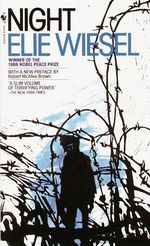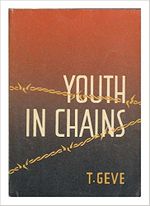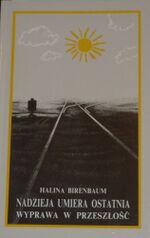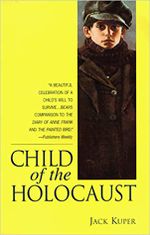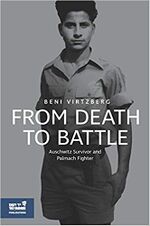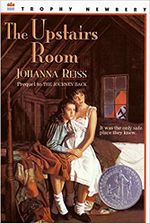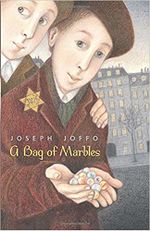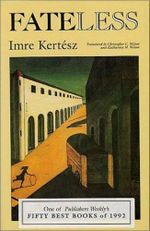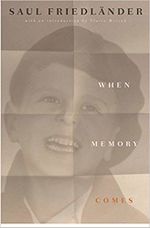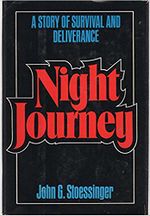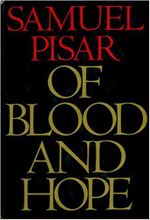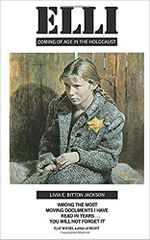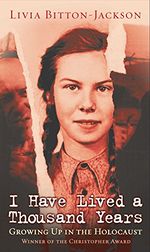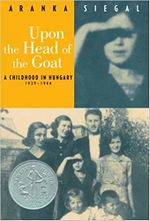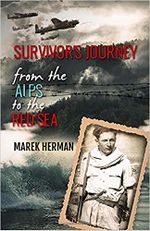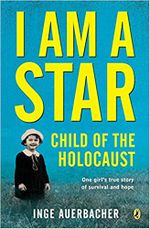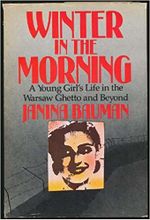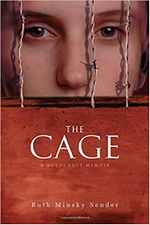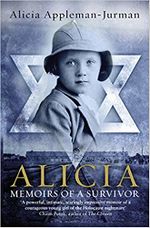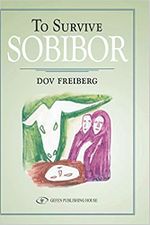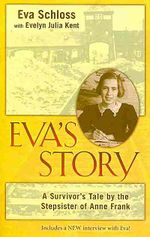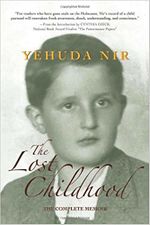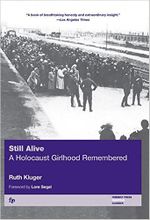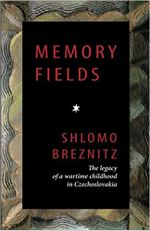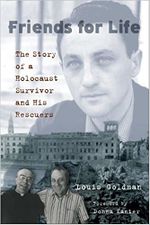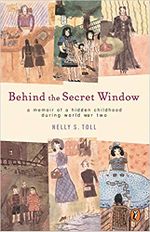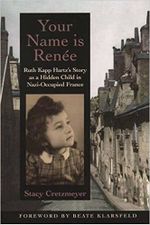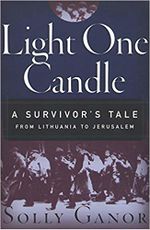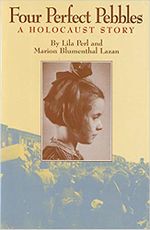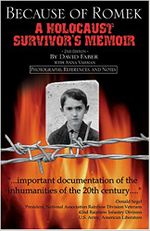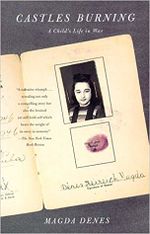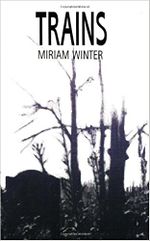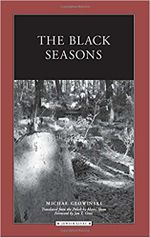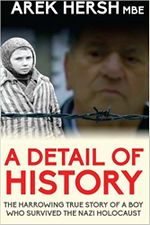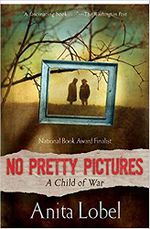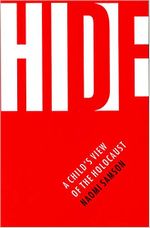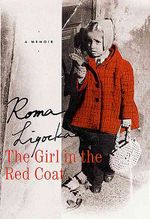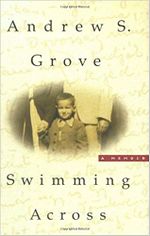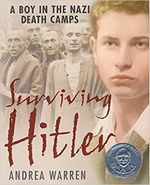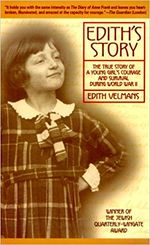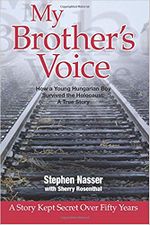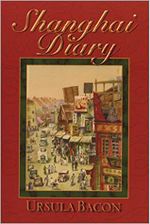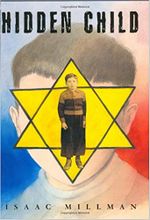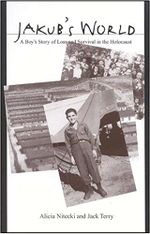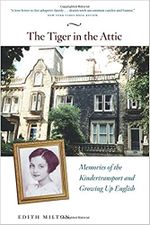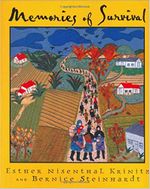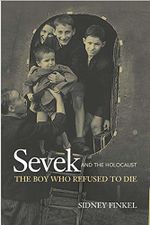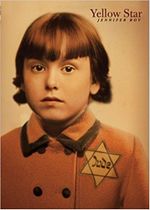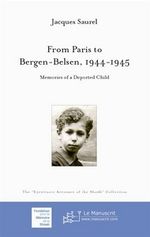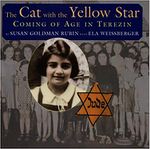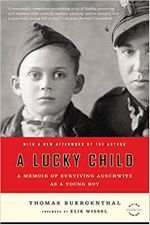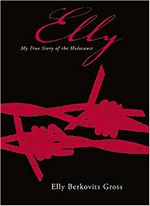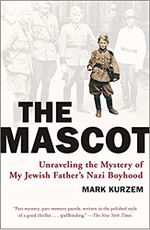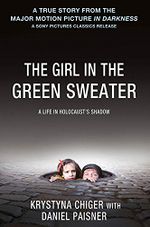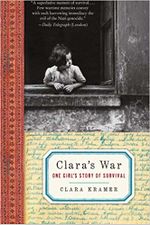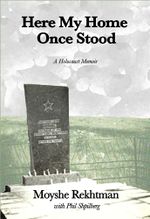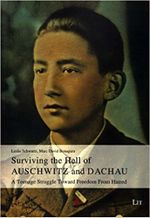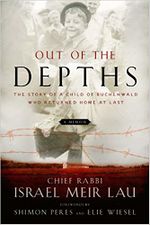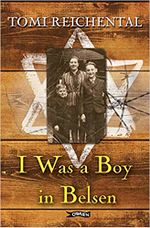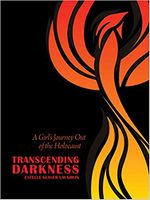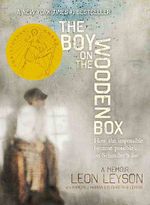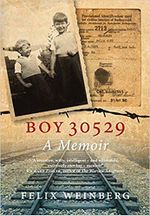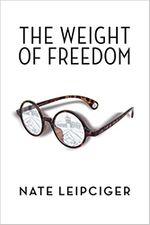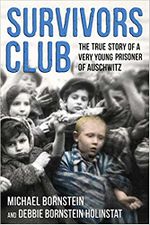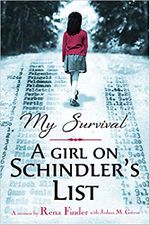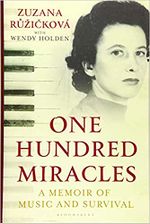Difference between revisions of "Category:Holocaust Children's Memoirs (subject)"
(→1978) |
(→1978) |
||
| Line 153: | Line 153: | ||
English ed. '''When Memory Comes ''' (New York : Farrar, Straus, Giroux, 1979). | English ed. '''When Memory Comes ''' (New York : Farrar, Straus, Giroux, 1979). | ||
Also translated into German. | Also translated into German, Hebrew, Spanish, and Italian. | ||
KEYWORDS: <Czechia> <France> <Hidden Children> <Catholic Church> / <Israel> | KEYWORDS: <Czechia> <France> <Hidden Children> <Catholic Church> / <Israel> | ||
| Line 159: | Line 159: | ||
"A classic of Holocaust literature, the eloquent, acclaimed memoir of childhood by a Pulitzer-winning historian, now reissued with a new introduction by Claire Messud ... Four months before Hitler came to power, Saul Friedländer was born in Prague to a middle-class Jewish family. In 1939, seven-year-old Saul and his family were forced to flee to France, where they lived through the German Occupation, until his parents' ill-fated attempt to flee to Switzerland. They were able to hide their son in a Roman Catholic seminary before being sent to Auschwitz where they were killed. After an imposed religious conversion, young Saul began training for priesthood. The birth of Israel prompted his discovery of his Jewish past and his true identity ... Friedländer brings his story movingly to life, shifting between his Israeli present and his European past with grace and restraint. His keen eye spares nothing, not even himself, as he explores the ways in which the loss of his parents, his conversion to Catholicism, and his deep-seated Jewish roots combined to shape him into the man he is today. Friedländer's retrospective view of his journey of grief and self-discovery provides readers with a rare experience: a memoir of feeling with intellectual backbone, in equal measure tender and insightful."--Publisher description. | "A classic of Holocaust literature, the eloquent, acclaimed memoir of childhood by a Pulitzer-winning historian, now reissued with a new introduction by Claire Messud ... Four months before Hitler came to power, Saul Friedländer was born in Prague to a middle-class Jewish family. In 1939, seven-year-old Saul and his family were forced to flee to France, where they lived through the German Occupation, until his parents' ill-fated attempt to flee to Switzerland. They were able to hide their son in a Roman Catholic seminary before being sent to Auschwitz where they were killed. After an imposed religious conversion, young Saul began training for priesthood. The birth of Israel prompted his discovery of his Jewish past and his true identity ... Friedländer brings his story movingly to life, shifting between his Israeli present and his European past with grace and restraint. His keen eye spares nothing, not even himself, as he explores the ways in which the loss of his parents, his conversion to Catholicism, and his deep-seated Jewish roots combined to shape him into the man he is today. Friedländer's retrospective view of his journey of grief and self-discovery provides readers with a rare experience: a memoir of feeling with intellectual backbone, in equal measure tender and insightful."--Publisher description. | ||
[[Saul Friedländer]] (France, 1932), Holocaust survivor]] -- | [[Saul Friedländer]] (France, 1932), Holocaust survivor]] -- | ||
====1978==== | ====1978==== | ||
Revision as of 10:28, 17 February 2020
Holocaust Children's Memoirs
- Holocaust Children -- Holocaust Children's Biographies -- Holocaust Children's Diaries -- Holocaust Children's Movies
1950s
1956
און די וועלט האָט געשוויגן / Un di Velt Hot Geshvign ["And the World Remained Silent"]<Yiddish> (Buenos Aires: Central Union of Polish Jews in Argentina, 1956). Revised French ed. La Nuit (Paris: Les Éditions de Minuit, 1960). Is the memoir written by Holocaust survivor Elie Wiesel (1928-2016).
English ed. The Night, trans. Stella Rodway (New York: Hill & Wang; and London: MacGibbon & Kee, 1960).
International bestseller. Translated in more than 20 languages.
KEYWORDS: <Romania> <Auschwitz> <death march> <Buchenwald>
"Night is Elie Wiesel's masterpiece, a candid, horrific, and deeply poignant autobiographical account of his survival as a teenager in the Nazi death camps. This new translation by Marion Wiesel, Elie's wife and frequent translator, presents this seminal memoir in the language and spirit truest to the author's original intent. And in a substantive new preface, Elie reflects on the enduring importance of Night and his lifelong, passionate dedication to ensuring that the world never forgets man's capacity for inhumanity to man ... Night offers much more than a litany of the daily terrors, everyday perversions, and rampant sadism at Auschwitz and Buchenwald; it also eloquently addresses many of the philosophical as well as personal questions implicit in any serious consideration of what the Holocaust was, what it meant, and what its legacy is and will be."--Publisher description.
Elie Wiesel (Romania, 1928-2016), Holocaust survivor -- Elie Wiesel was born in Sighet in Romania. He was 15 when in March 1944 his family, along with the rest of the town's Jewish population, was placed in one of the two confinement ghettos set up in Sighet. In May 1944, the Hungarian authorities, under German pressure, began to deport the Jewish community to the Auschwitz concentration camp. He lost his parents and his younger sister. Elie was eventually taken to Buchenwald, where he survived until liberation ... After World War II ended and Wiesel was freed, he joined a transport of 1,000 child survivors of Buchenwald to Ecouis, France, where the Œuvre de secours aux enfants (OSE) had set up a rehabilitation center. He was there reunited to his older sisters, who also had survived. Wiesel learned French and studied literature, philosophy and psychology at the Sorbonne. He began working as a journalist ... He was involved with Jewish causes and human rights causes and helped establish the United States Holocaust Memorial Museum in Washington, DC. In 1986 he was awarded the Nobel Peace Prize ... Died in 2016 in New York.
1958
Youth in Chains (Jerusalem : R. Mass, 1958) is the memoir written by Holocaust survivor Thomas Geve (b.1929).
KEYWORDS: <Germany> <Auschwitz> <Death March> <Buchenwald>
"The vivid, true, intimate story of Europe's youth under the heel of Fascism, their joys and sufferings, their day-to-day life and dreams -- told for the first time by one of them ... The author was taken to Auschwitz in 1942 when he was 13 years old and spent a total of 22 months in Auschwitz and Buchenwald before he was freed by the Allies in April 1945."--Publisher description.
Thomas Geve (Germany, 1929), Holocaust survivor -- Thomas Geve]] was born in Stettin and raised in Germany. During the war years, he worked for some months as a gravedigger at the Weißensee Cemetery. He was deported to Auschwitz in June 1943 with his mother who perished in the camp. He stayed in Auschwitz till its evacuation in January 1945, after which he still survived the death march, Gross-Rosen concentration camp and Buchenwald concentration camp until liberation in April 1945. Too weak to leave the camp, he proceeded to record camp life in 79 different drawings, before moving to a camp in Switzerland for orphaned shoah survivors. When his father was located, he was reunited with him in England. In 1950 he emigrated to Israel and settled in Haifa.
1959
Chi ti ama così <Italian> (Milan: Lerici, 1959) is the memoir written by Holocaust survivor Edith Bruck (b.1932).
English ed.: Who Loves You Like This, trans. Thomas Kelso (Philadelphia, Pa. : Paul Dry Books, 2001).
KEYWORDS: <Hungary> <Auschwitz> <Bergen-Belsen>
"Edith Bruck recreates the hardships of her existence as a Jewish child in Hungary before the Holocaust, the horrors of her time in the camps and the protracted pain and disorientation of her lonely return to normal life after the war ... Passover, 1944. Edith Bruck's family sits in a darkened kitchen isolated from the other villagers by the black cloth on the window, their poverty, and their Judaism. Her mother explains that the Germans have reached their Hungarian village—that they will soon have to endure more than the cries of "Jewstink" and the deprivations that have been their lot for months. The next morning twelve-year-old Edith is roused by shouts of "Wake up! Outside! Quickly! I give you five minutes, you animals!" ... In this memoir, Bruck tells the story of her imprisonment in Auschwitz, Dachau, and Bergen-Belsen. She and her older sister endure almost untellable horrors, and hunger so savage that the author tells of ripping bread from another's teeth. The end of the war brings freedom but little security. With no parents and no home, she moves from country to country, from household to household, and from relationship to relationship. In search of peace she and other family members immigrate to Israel, but even there peace eludes her. Bruck avoids both sentimentality and cynicism; she sees with clarity and passion, learns what she needs to survive, and catalogs other lessons for future use. At the end of Who Loves You Like This, she leaves Israel for Rome, where she lives today. In another country and in a foreign language, she finds the words to describe her life—without homeland, family, or native language."--Publisher description.
Edith Bruck (Hungary, 1932), Holocaust survivor -- Edith Brick was born in Hungary, the daughter of poor Jewish parents. In 1944, with her parents, and two brothers and a sister, she was sent to Auschwitz, where her mother died. The family was transferred to Dachau where her father died, then to Christianstadt and finally Bergen-Belsen, where the remaining children were liberated by the Allies in 1945. After returning to Hungary and then moving to Israel, she finally settled in Rome, Italy, since 1954. She embraced Italian as her new language. The wife of Italian writer and film director Nelo Risi, Bruck is the author of several novels, collections of short stories, and volumes of poetry. She writes for radio and television and has directed several films. Her works—for which she has won numerous literary prizes—have been translated from the original Italian into Dutch, German, Swedish, and Hungarian.
1960s
1967
Nadzieja umiera ostatnia (1967) is the memoir written by Holocaust survivor Halina Birenbaum (b.1927).
English ed. Hope Is the Last to Die (1994)
KEYWORDS: <Poland> <Warsaw Ghetto> <Majdanek> <Auschwitz>
"This book is an important work in Holocaust literature and was originally published in Poland in 1967. Covering the years 1939-1945, it is the author's account of her experience growing up in the Warsaw ghetto and her eventual deportation to, imprisonment in, and survival of the Majdanek, Auschwitz, Ravensbruck, and Neustadt-Glewe camps. Since the old, the weak, and children were summarily executed by the Nazis in these camps, Mrs Birenbaum's survival and coming of age is all the more remarkable. Her story is told with simplicity and clarity and the new edition contains revisions made by the author to the original English translation, and is expanded with a new epilogue and postscripts that bring the story up to date and complete the circle of Mrs Birenbaum's experiences."--Publisher description.
Halina Birenbaum (Poland, 1927), Holocaust survivor
1967
Child of the Holocaust (London: Routledge & K. Paul, 1967) is the memoir written by Holocaust survivor Jack Kuper (b.1932).
KEYWORDS: <Poland> <Hiding>
"Offers the true account of an eight-year-old boy who returned to his Polish town one day to find that all the Jews had been sent away and describes his young years traveling fearfully around the country in the hopes of finding his people and a place to call home."--Publisher description.
Jack Kuper (Poland, 1932), Holocaust survivor -- Jack Kuper (Jankele Kuperblum) survived the war alone as a street child, disguised for years as a Polish peasant and a Christian to escape the horrors of the Holocaust. After liberation he was placed in a Jewish orphanage in Lublin, Poland. He had to learn how to be a Jew again. During the years in hiding he had forgotten his language, culture and religion. In 1947, he was brought to Halifax by Canada’s Jewish community. He ended up settling in Toronto and working at the CBC.
1967
Milayl Habedolah Ve'ad Laylot Hakrav [From Kristallnacht to the Nights of Battle] (Jerusalem: Masada Press, 1967) is the memoir written by Holocaust survivor Beni Virtzberg (1928-1968).
English ed. From Death to Battle: Auschwitz Survivor and Palmach Fighter (Jerusalem: Yad Vashem, 2017).
KEYWORDS: <Germany> <Poland> <Ghetto> <Auschwitz> <Errand Boy> <Mengele> <Death March> <Mauthausen>
"When Beni Virtzberg was 9 years old, Kristallnacht destroyed his carefree childhood in his home town of Hamburg. Along with his parents, he was transported to Sosnowiec. Nazi Germany invaded Poland and the family shared the fate of many other Jews: internment in a ghetto, followed by deportation to Auschwitz. Beni's mother was murdered upon arrival. The young boy bravely fought to save his father's life, but he ultimately lost him as well. Beni's own fight for survival led him from Auschwitz, where he was forced to assist Joseph Mengele, to the death marches and to the notorious camps of Mauthausen and Melk. Upon liberation, Beni immigrated to Eretz Israel, joined the Palmach, and fought in some of the fiercest battles during Israel's War of Independence. During the Eichmann Trial, Beni decided to bear witness by writing his painful memoirs. The work on the book and the constant reminders of his agonizing past and losses took a great toll on him. On August 4, 1968, Beni Virtzberg took his own life."--Publisher description.
Beni Virtzberg (Germany, 1928-1968), Holocaust survivor -- Beni Virtzberg was born in Germany. In 1939 the family moved to Poland, but only to find themselves under German occupation. After living in the Sosnowiec and Środula ghetto, they were deported to Auschwitz. Beni only survived serving as Mengele's personal servant and errand boy. Forced into a death march, he arrived to Mauthausen and Melk until liberation. He moved to Israel in November 1945. Served in the army during the Israel's War of Independence and then worked for the Jewish National Fund as a forester. In 1967 he published his memoir but plagued with depression, took his own life.
1970s
1972
The Upstairs Room (1972) is the memoir written by Holocaust survivor Johanna Reiss (b.1932). <Juvenile audience>
KEYWORDS: <Netherlands> <Hiding>
"A classic WWII survivor story based on award-winning author Johanna Reiss’s own childhood during the Holocaust ... When the German army occupied Holland in 1940, Annie was only eight years old. Because she was Jewish, the occupation put her in grave danger. Most people thought the war wouldn’t last long, but Annie knew that if she wanted to stay alive, she would have to go into hiding. Fortunately, a Gentile family, the Oostervelds, offered refuge to Annie and her older sister, Sini. For two years they hid in the cramped upstairs room of the Oostervelds’s remote farmhouse. There, Annie and Sini would struggle to hold on to hope—separated from their family and confined to one tiny room—as a frightful and seemingly endless war raged on outside their window.
Johanna Reiss (Netherlands, 1932), Holocaust survivor
1973
Un Sac de billes <French> (1973) is the memoir written by Holocaust survivor Joseph Joffo (1931-2018).
English trans. A Bag of Marbles (Boston: Houghton Mifflin, 1974)
KEYWORDS: <France> <Hiding>
"When Joseph Joffo was ten years old, his father gave him and his brother fifty francs and instructions to flee Nazi-occupied Paris and, somehow, get to the south where France was free. Previously out of print, this book is a captivating and memorable story; readers will instinctively find themselves rooting for these children caught in the whirlwind of World War II.."--Publisher description.
Joseph Joffo (France, 1931-2018), Holocaust survivor -- Joseph Joffo was born in France to a Jewish family. When Joffo was ten, his father gave him and his 12-year-old brother Maurice five thousand francs each and instructions to flee Nazi-occupied Paris by foot, train and bus, and join their older brothers Henri and Albert in Menton on the Mediterranean coast. Joffo and Maurice travelled alone, managing to survive, until liberation. Joffo reunited with his mother and brothers in Paris in the family's barber shop--although sadly not their father, who perished in a concentration camp before the end of the war.
1975
Sorstalanság <Hungarian> (1975) is the memoir written by Holocaust survivor Imre Kertész (1929-2016).
English trans. Fateless / Fatelessness (1992)
KEYWORDS: <Hungary> <Auschwitz> <Buchenwald>
"At the age of 14 Georg Koves is plucked from his home in a Jewish section of Budapest and without any particular malice, placed on a train to Auschwitz. He does not understand the reason for his fate. He doesn’t particularly think of himself as Jewish. And his fellow prisoners, who decry his lack of Yiddish, keep telling him, “You are no Jew.” In the lowest circle of the Holocaust, Georg remains an outsider ... The genius of Imre Kertesz’s unblinking novel lies in its refusal to mitigate the strangeness of its events, not least of which is Georg’s dogmatic insistence on making sense of what he witnesses–or pretending that what he witnesses makes sense. Haunting, evocative, and all the more horrifying for its rigorous avoidance of sentiment, Fatelessness is a masterpiece in the traditions of Primo Levi, Elie Wiesel, and Tadeusz Borowski."--Publisher description.
Imre Kertész (Hungary, 1929-2016), Holocaust survivor
1977
העטרה שאבדה : בגיטו לודז׳ ובמחנות / ha-ʻAṭarah she-avdah: be-geṭo Lodz' uva-maḥanot <Hebrew> (Tel Aviv: Bet loḥame ha-getaʼot ṿe-hotsaʼat ha-Ḳibuts ha-meʼuḥad, 1977) is the memoir written by Holocaust survivor Sara Zyskind (1927-1995).
English trans. Stolen Years (Minneapolis, MN: Lerner Publications Co., 1981)
KEYWORDS: <Poland> <Lodz Ghetto> <Auschwitz>
"Presents a personal account of the author's experiences as a young Jewish girl living in Poland at the beginning of its occupation by Nazi Germany in World War II."--Publisher description.
Sara Zyskind (1927-1995) was born in Lodz to a a well-known Jewish family of industrialists. At the age of 12, she and her family were forced to live in the Lodz ghetto. Her mother died in 1940. She and her father mutually supported each other during the following years, successfully evading arrest and deportation, until he died during the Passover of 1943. Upon the "liquidation" of the Ghetto, at the age of 16, Zyskind was deported to Auschwitz in August 1944, and from there to other labor camps. After liberation she emigrated to Palestine, where she lived ever after.
1978
Quand vient le souvenir <French> (1978) is the memoir written by Holocaust survivor Saul Friedländer (b.1932).
English ed. When Memory Comes (New York : Farrar, Straus, Giroux, 1979).
Also translated into German, Hebrew, Spanish, and Italian.
KEYWORDS: <Czechia> <France> <Hidden Children> <Catholic Church> / <Israel>
"A classic of Holocaust literature, the eloquent, acclaimed memoir of childhood by a Pulitzer-winning historian, now reissued with a new introduction by Claire Messud ... Four months before Hitler came to power, Saul Friedländer was born in Prague to a middle-class Jewish family. In 1939, seven-year-old Saul and his family were forced to flee to France, where they lived through the German Occupation, until his parents' ill-fated attempt to flee to Switzerland. They were able to hide their son in a Roman Catholic seminary before being sent to Auschwitz where they were killed. After an imposed religious conversion, young Saul began training for priesthood. The birth of Israel prompted his discovery of his Jewish past and his true identity ... Friedländer brings his story movingly to life, shifting between his Israeli present and his European past with grace and restraint. His keen eye spares nothing, not even himself, as he explores the ways in which the loss of his parents, his conversion to Catholicism, and his deep-seated Jewish roots combined to shape him into the man he is today. Friedländer's retrospective view of his journey of grief and self-discovery provides readers with a rare experience: a memoir of feeling with intellectual backbone, in equal measure tender and insightful."--Publisher description.
Saul Friedländer (France, 1932), Holocaust survivor]] --
1978
Kinderjaren <Dutch> (1978) is the memoir written by Holocaust survivor Jona Oberski (b.1938).
English trans. Childhood. Garden City, NY: Doubleday, 1983 / repr. New York, NY: Penguin Books, 2014.
Translated into English, French, German, Italian, Spanish
KEYWORDS: <Netherlands> <Bergen-Belsen> <Ghost Train>
"Told from the perspective of a child slowly awakening to the atrocities surrounding him, Childhood is a searing story of the Holocaust that no reader will soon forget. As five-year-old Jona waits with his mother and father to emigrate from Nazi-occupied Amsterdam to Palestine, they are awakened at night, put on a train, and eventually interred in the camps at Bergen-Belsen. There, what at first seems to be a merely dreary existence soon reveals itself to be one of the worst horrors humanity has ever created. A triumph of heartrending clarity and dispassionate amazement, Childhood stands tall alongside such monuments of Holocaust literature as The Diary of Anne Frank, Elie Wiesel’s Night, and Primo Levi’s Survival in Auschwitz."--Publisher description.
1978
Night Journey: A Story of Survival and Deliverance (1978) is the memoir written by Holocaust survivor John G. Stoessinger (Austria, 1927-2017)
KEYWORDS : <refugee> <China>
"The story begins with Hitler arriving in Vienna where young Stoessinger hears his governess making love to an SS officer and telling him, ""I want a son for the FÜhrer."" The family flees to Prague and then Shanghai, and Stoessinger finally comes to the U.S. to attend Grinnell College. He is tossed out two weeks before graduation--his diploma comes by mail--for getting his girlfriend pregnant. They marry, but he leaves her to attend Harvard Graduate School. A series of academic posts and honors, a second wife, and a UN assignment later, he meets an attractive con artist who becomes his mistress, gets him to write her letters of introduction to foreign banks and governments, and lends him $80,000. Both are indicted--she for fraud, he for falling to report a crime--and in a headline-grabbing trial, an assistant prosecutor tells him, ""I know you are not a criminal but you sure were dumb."" In cathartic fashion, Stoessinger willingly acknowledges his naivetÉ and discusses his thoughts of suicide, and his final resolve ""to play out his hand.""--Publisher description.
1979
Le sang de l'espoir <French> (Paris: Laffont, 1979) is a memoir written by Holocaust survivor Samuel Pisar (1929-2015).
English trans. Of Blood and Hope (Boston : Little, Brown, 1980).
KEYWORDS: <Poland> <Auschwitz> <Death March>
"A survivor of Auschwitz recounts his harrowing experiences, his adjustment to freedom, and his work on behalf of the Jewish cause."--Publisher description.
Samuel Pisar (1929-2015) was born in Białystok, Poland, to a Jewish family. He was sent to Majdanek, Bliżyn, Auschwitz, Sachsenhausen, Oranienburg, Dachau and ultimately to the Engelberg Tunnel near Leonberg. At the end of the war, he escaped during a death march. After the liberation, Pisar spent a year and a half in the American occupation zone of Germany, engaging in black marketeering with fellow survivors. He was rescued by an aunt living in Paris. An uncle sent him to Melbourne, Australia, where he resumed his studies and became a lawyer, moving back to France and the United States.
1980s
1980
Elli : Coming of Age in the Holocaust (New York : Times Books, 1980) is a memoir written by Holocaust survivor Livia Bitton-Jackson (b.1931).
KEYWORDS: <Czechoslovakia> <Auschwitz> <Dachau>
"In a wrenching memoir of pain, persecution, and degradation, the author relives the Nazi terrors that engulfed her and her family in Czechoslovakia. She also relates the horrors of the concentration camp ... From her small, sunny hometown between the beautiful Carpathian Mountains and the blue Danube River, Elli Friedmann was taken-at a time when most girls are growing up, having boyfriends and embarking upon the adventure of life-and thrown into the murderous hell of Hitler's Final Solution. When Elli emerged from Auschwitz and Dachau just over a year later, she was fourteen. She looked like a sixty-year-old. This account of horrifyingly brutal inhumanity-and dogged survival - is Elli's true story."--Publisher description
In 1997 the author wrote a version of her autobiography for juvenile audience. I Have Lived a Thousand Years: Growing Up in the Holocaust (New York, NY: Simon & Schuster Books for Young Readers, 1997).
"What is death all about? What is life all about? So wonders thirteen-year-old Elli Friedmann as she fights for her life in a Nazi concentration camp. A remarkable memoir, I Have Lived a Thousand Years is a story of cruelty and suffering, but at the same time a story of hope, faith, perseverance, and love. It wasn’t long ago that Elli led a normal life that included family, friends, school, and thoughts about boys. A life in which Elli could lie and daydream for hours that she was a beautiful and elegant celebrated poet. But these adolescent daydreams quickly darken in March 1944, when the Nazis invade Hungary. First Elli can no longer attend school, have possessions, or talk to her neighbors. Then she and her family are forced to leave their house behind to move into a crowded ghetto, where privacy becomes a luxury of the past and food becomes a scarcity. Her strong will and faith allow Elli to manage and adjust, but what she doesn’t know is that this is only the beginning. The worst is yet to come..."--Publisher description.
Livia Bitton-Jackson (b.1931) was born as Elli L. Friedmann in Samorin, Czechoslovakia, on February 28, 1931. She was 13 years old when her family was taken to Ghetto Nagymagyar. Eventually, they were transported to Auschwitz, and other camp, until liberation. Bitton-Jackson came to the U.S. on a refugee boat in 1951 to join her brother, who was studying in New York. She studied at New York University, from which she received a Ph.D. in Hebrew Culture and Jewish History. She was then a professor of history at City University of New York for 37 years.
1981
האי ברחוב הציפורי <Hebrew> (Jerusalem: 1981) is a semi-autobiographical novel written by Holocaust survivor Uri Orlev (b.1931).
English trans. The Island on Bird Street (Boston, MA: Houghton Mifflin, 1984).
KEYWORDS: <Poland> <Warsaw Ghetto>
"During World War II a Jewish boy is left on his own for months in a ruined house in the Warsaw Ghetto, where he must learn all the tricks of survival under constantly life-threatening conditions."--Publisher description.
Uri Orlev (b.1931)
1981
Upon the Head of the Goat: A Childhood in Hungary (New York, NY: Farrar Straus Giroux, 1981) is a memoir written by Holocaust survivor Aranka Siegal (b.1930).
KEYWORDS: <Hungary> <Ghetto>
"The classic true story of one child's experiences during the holocaust, who witnesses the destruction of her family at the hands of the Nazis during World War II ... Nine-year-old Piri describes the bewilderment of being a Jewish child during the 1939-1944 German occupation of her hometown (then in Hungary and now in the Ukraine) and relates the ordeal of trying to survive in the ghetto ... Upon the Head of the Goat is the winner of the 1982 Boston Globe - Horn Book Award for Nonfiction and a 1982 Newbery Honor Book."--Publisher description.
Aranka Siegal (b.1930).
1985
From the Alps to the Red sea (Israel:Ghetto Fighters' Museum, 1985) is a memoir written by Holocaust survivor Marek Herman (b.1927). Repr. 2020.
KEYWORDS: <Poland> <Lvov Ghetto> <Italy> <Jewish Resistance>
"An orphan boy. Life under a fake identity. A heroic tale of survival. Marek Herman’s life had not easy from the beginning ... And yet, not even growing up an orphan in the city of Lvov, Poland, had prepared him for what the future had in store ... Nazi Germany invades Poland in 1939 and changes the lives of people in the entire continent ... Jews instantly come under persecution. In order to save himself, Marek, lives under a borrowed identity, and crosses the border into Italy together with the Italian soldiers who were stationed in Poland ... A chance encounter he happens to witness, completely transforms the rest of his life ... Marek immediately joins the resistance in Northern Italy, where the Jewish boy fights side by side with his new friends, the anti-fascist fighters ... Survivor's Journey From the Alps to the Red Sea is a spine-tingling book of memoirs, describing Marek Herman’s life, heroism and hope for a better future during all the vicissitudes he goes through from Poland, through the Alps, and all the way to the Red Sea."--Publisher description.
Marek Herman (Poland, 1927), Holocaust survivor
1986
I Am a Star: Child of the Holocaust (New York, NY: Prentice-Hall Books for Young Readers, 1986) is the memoir written by Holocaust survivor Inge Auerbacher (b.1934).
KEYWORDS: <Germany>
"The author's reminiscences about her childhood in Germany, years of which were spent in a Nazi concentration camp. Includes several of her original poems ... Inge Auerbacher’s childhood was as happy and peaceful as that of any other German child—until 1942. By then, the Nazis were in power, and because Inge’s family was Jewish, she and her parents with sent to a concentration camp in Czechoslovakia. The Auerbachers defied death for three years, and were finally freed in 1945. In her own words, Inge Auerbacher tells her family’s harrowing story—and how they carried with them ever after the strength and courage of will that allowed them to survive."--Publisher description.
Inge Auerbacher (b.1934)
1986
Winter in the Morning: a young girl's life in the Warsaw ghetto and beyond (1986) is the memoir written by Holocaust survivor Janina Bauman (b.19).
KEYWORDS: <Poland> <Warsaw Ghetto> <Hiding>
"The coming-of-age of a young girl during World War II. She was born to a wealthy doctor, then she and her family were rounded up and imprisoned in the Warsaw Ghetto to live a disease-ridden, hand-to-mouth existence, always in the presence of death. The family then escaped to the "Aryan" side where they had to slip from one safe-house to another, in constant fear of discovery and under the constant threat of blackmail ... Janina Bauman was a year older than Anne Frank when the Second World War began but, unlike The Diary of Anne Frank, this is a story of survival. When Hitler's decree forced her family into the Warsaw Ghetto, Janina, an intelligent, lively girl, suddenly found herself in a cramped flat, hiding with other Jewish families. At first even curfews and the casual cruelty meted out by the German occupiers could not dim her passion for books, boys and romance. Then came the raids, and Janina, with her sister and mother, had to keep on the move, hiding in the ruins of the ghetto to avoid being one of thousands rounded up every day and deported to the camps. Their escape to the 'Aryan' side was followed by two years in hiding, taking shelter with those willing to help them and living in constant fear of betrayal. Told through her teenage diaries, giving her story a rare immediacy, this is the extraordinary tale of a passionate young woman's courage and survival."--Publisher description.
1986
The Cage (1986) is the memoir written by Holocaust survivor Ruth Minsky Sender (b.1926).
KEYWORDS: <Poland> <Lodz Ghetto> <Auschwitz>
"After Riva’s mother was taken away by the Nazis, Riva and her younger brothers were left to cling to their mother’s brave words to help them endure life in the Lodz ghetto. Then the family is rounded up, deported to Auschwitz, and separated. Now Riva is alone ... At Auschwitz, and later in the work camps at Mittlesteine and Grafenort, Riva vows to live, and to hope—for Mama, for her brothers, for the millions of other victims of the nightmare of the Holocaust. And through determination and courage, and unexpected small acts of kindness, she does live. And this unforgettable memoir of love, strength, and survival is her story."--Publisher description.
Ruth Minsky Sender (b.1926)
1988
Alicia (Toronto, and New York : Bantam Books, 1988) is the memoir written by Holocaust survivor Alicia Appleman-Jurman (1930-2017).
KEYWORDS: <Poland> <Hiding>
"Her name is Alicia. She was five-years-old when her story begins. It is 1935 and she is living in the East Polish town of Buczacz. Although brought up in an atmosphere of anti-Semitism, nothing could prepare this young girl for the Russian invasion of Poland and the full horror of the Nazi Occupation. When Alicia was thirteen, she fled the Nazis through the forests and fields of Poland. Despite her youth, she rescued other Jews from the grip of the Gestapo. At the end of the war, Alicia, whose parents and four brothers had all perished in the Holocaust, risked her life again – this time leading other survivors from Poland to Palestine through an underground route. Her capacity for heroism in the face of brutality and evil shines through, and her story cannot easily be forgotten. She swore on her brother's grave that if she survived, she would speak for her silenced family. This book is the eloquent fulfillment of that oath. ... Told simply and modestly, this is a remarkable tribute to courage and determination, and how one young woman survived the horrors of war-torn Europe."--Publisher description.
Alicia Appleman-Jurman (1930-2017).
1988
To Survive Sobibor (1988) is the memoir written by Holocaust survivor Dov Freiberg (1927-2008).
KEYWORDS: <Poland> <Sobibor>
"This is the story of a survivor, the story of his life before the Holocaust and after- as he struggles for sanity while facing his own tragedy until he boards the illegal immigrant vessel Yetziat Europa 1947 (better known as the Exodus)."--Publisher description.
Dov Freiberg (Poland, 1927-2008), Holocaust survivor -- Born in Warsaw in 1927, Dov Freiberg spent his early childhood years in Warsaw and Lodz in the enveloping embrace of his family. One of the few survivors of the Sobibor death camp and a veteran of the famous illegal immigrant vessel Exodus, he has lived in Israel since 1948, fought in the 1948 Israeli War of Independence, the 1967 Six-Day War and the 1973 Yom Kippur War. He dedicated his life to the memory of the victims of the Holocaust and testified in the Eichmann trial in Jerusalem, as in several other high-profile Nazi war crimes trials. He lectures regularly for students, soldiers and educational institutions. To Survive Sobibor (1988) is Dov Freiberg's first book to be translated into English. His other books are : A Journey To The Past With Dekel Shibolim (1993), A Man as Any Other(1996) and Two Worlds (2001).
1988
Eva's Story: A Survivor's Tale (New York : St. Martin's Press, 1988) is the memoir written by Holocaust survivor Eva Schloss (1929).
KEYWORDS:
"Many know the tragic story of Anne Frank, the teen whose life ended at Auschwitz during the Holocaust. But most people don’t know about Eva Schloss, Anne’s playmate and stepsister. Though Eva, like Anne, was taken to Auschwitz at the age of 15, her story did not end there. / This incredible memoir recounts — without bitterness or hatred —the horrors of war, the love between mother and daughter, and the strength and determination that helped a family overcome danger and tragedy."--Publisher description.
Eva Schloss (b.1929).
1989
The Lost Childhood (San Diego : Harcourt Brace Jovanovich, 1989) is the memoir written by Holocaust survivor Yehuda Nir (1930-2014).
KEYWORDS: <Poland> <Hiding>
"The story of six extraordinary years in the life of a Polish Jewish boy who, along with his mother and sister, survived World War II through cunning, deceit, and guile ... This compelling memoir takes readers through the eyes of a child surviving World War II in Nazi-occupied Poland. As a nine-year-old, the author witnessed his father being herded into a truck—never to be seen again. He, his mother, and sister fled to Warsaw to live in disguise as Catholics under the noses of the Nazi SS, constantly fearful of discovery and persecution. A sobering reminder of the personal toll of the Holocaust on Jews during World War II, this book is a harrowing portrait of one child's loss of innocence. This edition contains previously unpublished content from the original text."--Publisher description.
Yehuda Nir (1930-2014) was born Juliusz Gruenfeld in Lwów, Poland. Nir and his family posed as Roman Catholics and learned Latin to escape Nazi persecution in Poland during World War II. Nir's ordeal led him to a career as a psychiatrist, specializing in the treatment of post-traumatic stress disorder and severely ill children. He immigrated to the United States in 1959.
1990s
1991
La Petite Fille Du Vel d'Hiv (1991) is a memoir written by Holocaust survivor Annette Muller.
KEYWORDS: <France>
1992
Weiter Leben: eine Jugend <German> (1992) is a memoir written by Holocaust survivor Ruth Klüger (b.1931).
English trans. Still Alive: A Holocaust Girlhood Remembered (New York, NY: Feminist Press at the City University of New York, 2001)
KEYWORDS: <Austria>
"Swept up as a child in the events of Nazi-era Europe, Kluger saw her family's comfortable Vienna existence destroyed. Despite her shattered childhood, Kluger eventually reclaimed her life. A coming-of-age story that delves into the unsentimental observations of childhood, "Still Alive" rejects easy assumptions about history as Kluger relates how she and her family survived the Holocaust."--Publisher description.
Ruth Klüger (b.1931).
1993
Sedot ha-zikaron (Tel Aviv : `Am `oved, 1993) is the memoir written by Holocaust survivor Shlomo Breznitz (b.1936).
English ed. Memory Fields: The Legacy of a Wartime Childhood in Czechoslovakia (New York: Knopf, 1993). Also translated into German.
KEYWORDS: <Czechia> <Hiding> <Church>
"Memory Fields recounts Shlomo Breznitz’s devastating experiences upon being placed in a Sisters of Saint Vincent orphanage just hours before his parents were sent to Auschwitz. He tells of events with other orphans, his teacher, classmates, the prelate and dreaded visits by Nazi officers periodically searching for Jewish children. He describes overwhelming feelings of isolation and loneliness, and persistent dread of being discovered. Interwoven throughout the book, Breznitz, the psychologist, draws on his history and explores the nature of cruelty and kindness, of stifling fear and outstanding courage, and the ways in which memory shapes our lives. University of Haifa psychology professor Breznitz, who was caught up in the Holocaust as a child, has written a spare and eloquent memoir of his experiences. Born into a Jewish family in Bratislava, Czechoslovakia, he narrowly avoided transport to a concentration camp, because his parents, who were soon shipped to Auschwitz, managed to place the six-year-old Shlomo and his 10-year-old sister, Judith, in a Catholic orphanage, where they remained until the end of the war. There Shlomo strove to become a good Christian, hiding his circumcision from the other boys, who frequently treated him cruelly, and memorizing the Catholic litany so well that he was chosen to recite for the prelate. The pain of his memories of the convent was reinforced by an anti-Semitic incident that took place in 1959 when the author was traveling through Hungary as a member of the Israeli student chess team. The book is a moving contribution to Holocaust literature."--Publisher description.
"Moving artfully and easily from past to present, from a child's perspective to an adult's, Shlomo Breznitz's many voices relate this poignant, gripping, and often terrifying memoir. Caught in Czechoslovakia during the Holocaust, Breznitz and his family moved from village to village until it became clear that there was no escaping the Nazis. Before they were sent to Auschwitz, however, Breznitz's parents persuaded the Sisters of Saint Vincent to take their two recently converted children into the convent's orphanage. Shlomo - called Juri - was just six years old. Separated from his parents and from his sister, Judith (the nuns segregated the sexes, and communication between them was rarely allowed), Juri recounts his often devastating experiences with the other orphans, the nuns, his teacher and classmates at the village school, the prelate and the mother superior, and the Nazi officers who periodically visited the orphanage. He describes his overwhelming feelings of isolation and loneliness, his persistent dread of being found out as a "stinking Jew" (constantly hiding his circumcision), his earnest determination to be a good Catholic, and the crushing sense of danger that loomed over him at every moment. Memory Fields, however, goes beyond its recollections of childhood. It speaks also for Breznitz the psychologist, as he explores the nature of cruelty and kindness, of stifling fear and outstanding courage, of memory and the ways in which it shapes our lives. In the last chapter of the book, almost fifty years later Breznitz returns to Czechoslovakia and revisits the places so vivid in his memory, in hopes of finding the nuns who saved his and his sister's life. A stunning and evocative story, beautifully told."--Publisher description.
Shlomo Breznitz (1936)
1993
Amici per la vita (Firenze : Ed. Sp44, 1993) is the memoir written by Holocaust survivor Louis Goldman (1925-1996), regarding himself and his younger brother Harry Goldman (1931-1948).
English ed. Friends for Life: The Story of a Holocaust Survivor and His Rescuers (New York : Paulist Press, 2008)
KEYWORDS: <Germany> <Refugees> <France> <Italy> <Hiding>
"This extraordinary book is a tribute to a group of young Catholic priests who, for two years, from 1943 to 1945, risked their life to save Jews from the Nazis. The author, a noted photographer, came to the US after the war and became a photographer for the entertainment arts. However, he was compelled to recount the story of the events of his life and family, which survived the Holocaust in Italy, and the Italian clergy who had saved them. His memories are raw, agonizing, sorrowful, yet touched with poignant hope, and the relief of eventual liberation Readers will not fail to be moved by these stirring and painful memories that are marked with the example of these courageous priests who spared no efforts to save Goldman's family's life, as well as the lives of many others. Absorbing, wonderfully written, and, heart-rending, and, ultimately, life affirming, this book deserves to be widely read. A comparison with Anne Frank is not overstating its merit."--Publisher description.
Louis Goldman (1925-1996) and his brother Harry Goldman (1931-1948) survived as refugees in France and in hiding in Italy, with the help of some Catholic priests. Harry died in the Israel’s War of Independence. Louis moved to the United States where he had a successful career as a photographer.
1993
Behind the Secret Window: A Memoir of a Hidden Childhood during World War Two (New York: Dial Books, 1993) is the memoir written by Holocaust survivor Nelly S. Toll (1935), regarding herself and her mother.
KEYWORDS: <Poland> <Lvov Ghetto> <Hiding>
"The author recalls her experiences when she and her mother were hidden from the Nazis by a Gentile couple in Lwów, Poland, during World War II ... Illustrated with Nelly's original watercolors, this powerful memoir tells the true story of how a little girl's imagination helped her survive World War II ... The Nazis come to Poland when Nelly is six. By the time she turns eight, the events of World War II have taken almost everyone she loves. Scared, lonely, and running from the Nazis, Nelly hides in the bedroom of a Gentile couple in Lwow, Poland. For over a year, she lives in fear of discovery, writing in her diary and painting pictures of a fantasy world filled with open skies and happy families ... For 13 months during World War II, the author and her mother were hidden from the Nazis. Like Anne Frank, Nelly kept a diary and through that outlet transformed her grim reality into an enchanting fantasy world ... Without emphasizing horror and loss, Toll conveys the effects of human evil and human folly, summoning up the forces of tragedy and courage ... In Toll's remembrance, art equals hope: her happy family pictures, painted in the secret room where she and her mother hid from the Nazis and the Poles, show extraordinary preteen talent as well as the will to survive"--Publisher description.
Nelly S. Toll (Poland, 1935)
1994
Dank meiner Mutter <German> (Frankfurt am Main: Alibaba, 1994) is a memoir written in German by Holocaust survivor Schoschana Rabinovici (Suzanne Weksler; 1932-2019). Originally published in German in 1994.
English trans. Thanks to My Mother (New York, NY: Puffin, 1998).
KEYWORDS: <Lithuania> <Vilnius Ghetto>
"Susie Weksler was only eight when Hitler's forces invaded her Lithuanian city of Vilnius. Over the next few years, she endured starvation, brutality, and forced labor in three concentration camps. With courage and ingenuity, Susie's mother helped her to survive--by disguising her as an adult to fool the camp guards, finding food to add to their scarce rations, and giving her the will to endure. This harrowing memoir portrays the best and worst of humanity in heartbreaking scenes you will never forget."--Publisher description.
Schoschana Rabinovici (1932-2019) was born in Paris on November 14, 1932 where her parents were completing their studies. After the Wekslers returned to Vilnius, Susie attended Jewish school until the German occupation of the city in June 1941. She survived Vilnius Ghetto and the Kaiserwald and Stutthof Nazi concentration camps as a young girl (ages 8 to 12). After the war Weksler attended school in Poland and in 1950 she immigrated to Israel. She married David Rabinovici in 1953. Suzanne Weksler, now Schoschana Rabinovici, lived in Tel Aviv and Vienna since 1964, until her death in 2019.
1994
Your Name Is Renée: Ruth Kapp Hartz's Story as a Hidden Child in Nazi-Occupied France (New York : Oxford University Press, 1994) is the story of Holocaust survivor Ruth Kapp Hartz (b.1937) written by Stacy Cretzmeyer.
KEYWORDS: <France> <Hiding> <Catholic Church>
"Tells the story of Ruth Kapp, a young Jewish girl in Nazi-occupied France in 1941, who, after being separated from her family, lived out the war hidden in a Catholic convent until being reunited with her parents in the final months of the conflict ... In Nazi-occupied France in 1941, four-year-old Ruth Kapp learns that it is dangerous to use her own name. "Remember," her older cousin Jeannette warns her, "your name is Renee and you are French!" A deeply personal book, this true story recounts the chilling experiences of a young Jewish girl during the Holocaust. The Kapp family flees one home after another, helped by simple, ordinary people from the French countryside who risk their lives to protect them. Eventually the family is forced to separate, and young Ruth survives the war in an orphanage where she is not allowed to see or even mention her parents. Without the trappings of lofty language or the faceless perspective of history, this first-person account poignantly recreates the terror of war seen through the eyes of an innocent child. Your Name Is Renee is a tale of suffering and redemption, fear and hope."--Publisher description.
Ruth Kapp Hartz (b.1937) -- Ruth (Renee) Hartz, nee Kapp, born in Palestine of German-Jewish parents in 1937, moved with her family to Paris in 1938. After the invasion of France in 1940, they were sent with other non-French to Colombers, a sports stadium outside of Paris. Her father avoided deportation by joining the French Foreign Legion in Morocco. With the help of the Resistances, Ruth and her mother fled to Normandy, with false papers, hiding on a farm, then to Toulouse and Arthes near Albi in the French Free Zone, where father joined them in 1942. She describes flight, hunger and painful separation from her parents when she was hidden in a Sorēze convent in Sortčze. After one year, the family reunited and was helped with food and hiding by two generations of a Catholic family, with whom they remain in contact. After the war, the family moved to Paris. Ruth experienced antisemitism in school and later at the Sorbonne and found protection hiding her Jewishness as she had during the war. Joining the Jewish scouts (Les Éclaireurs) and WIZO reinforced her Jewish identity. She emigrated to the US in 1958.
1995
An End to Childhood (1995) is a novel written by Holocaust survivor Miriam Akavia (1927-2015).
KEYWORDS: <Lvov Ghetto>
"This memoir, written as fiction, but based on fact, describes the fear-filled efforts of a pair of Polish adolescents, brother and sister, to survive in secrecy and constant anxiety in Lvov at a time when Jews were being rounded up and sent to the Ghetto - or worse. They have only their false identity papers, their few trusted contacts and their own wits to help them conceal their Jewish background and keep one step ahead of the German authorities. Miriam Akavia, who experienced at first hand similar terrors and anxieties, skillfully conveys the fluctuations in mood from the natural optimism and high spirits of youth to the painfully learned caution and dissembling forced upon them by their situation."--Publisher description.
Miriam Akavia (1927-2015) was born in Krakow.
1995
Light One Candle: A Survivor's Tale from Lithuania to Jerusalem (1995) is a memoir written by Holocaust survivor Solly Ganor (b.1928).
KEYWORDS: <Lithuania> <Kaunas Ghetto>
"Forty-seven years after he was found half-dead in the snow, following a death march from Dachau, Solly Ganor again came face to face with his rescuer Clarence Matsumura at a reunion of Holocaust survivors and their American liberators. That meeting proved a catharsis, enabling Ganor to confront for the first time the catalogue of horrors he experienced during the Second World War. Beginning in prewar Lithuania, Light One Candle tells of the ominous changes that took place once Hitler came to power in 1933, of Chiune Sugihara, the Japanese consul who wrote thousands of exit visas for Jews fleeing the Nazi onslaught, of the brutal conditions in the Kaunas ghetto where Ganor spent most of the war, and of Stutthoff and Dachau, the concentration camps he was shuttled to and from in the last, desperate days of the war. Unflinching in its depiction of evil but uplifting in its story of the survival of the human spirit, Light One Candle is a gripping memoir that waited fifty years to be told."--Publisher description.
Solly Ganor (b.1928)
1996
Ein Kind unserer Zeit (Frankfurt am Main: dipa-Verl., 1996) is a memoir written by Holocaust survivor Ruth L. David (b.1929).
English ed. Child of Our Time: A Young Girl's Flight from the Holocaust (London: Tauris, 2002).
KEYWORDS: <Germany> <Kindertransport>
"Child of Our Time is the inspiring story of a little girl caught in the vortex of one of history’s great horrors. Plucked from deep rural Germany, after witnessing the horror of Kristallnacht and her family’s eviction from its village, Ruth David was sent to England as part of the Kindertransport—one of the few routes to safety and survival for many children who were to lose their parents in the Holocaust ... As a child of the Holocaust, David was one of the lucky ones: she was one of about 10,000 Jewish children who were taken by train to Great Britain and saved from death at the hands of the Nazis. "As a child I found it difficult to be grateful for this," she notes in a foreword to her own children. "I wanted to be with my family, wherever they were...." She was fortunate in another sense-her four siblings also survived the war. But David never saw her parents again after her departure for England: they perished in Auschwitz. She movingly describes her arrival in London, aged 10, part of a group of "tired, frightened children"; her gradual assimilation into the life of the hostel where she stayed; the strangeness of daily things such as corn flakes, which she had never seen before; up through the beginning of her new life when, at age 17, she left the hostel after the war. David notes she had never spoken about these events to her children. Readers will be glad she decided to share her moving experiences now."--Publisher description.
Ruth L. David (Germany, 1929), Holocaust survivor -- Born in Germany, Ruth L. David lived in England from 1939-1992 as a teacher of modern languages. She now lives in Ames, Iowa.
1996
Four Perfect Pebbles: A Holocaust Story (New York: Greenwillow Books, 1996) is a memoir written by Holocaust survivor Marion Blumenthal Lazan, with Lila Perl.
KEYWORDS: <Westerbork> <Bergen-Belsen>
"Marion Blumenthal Lazan’s unforgettable and acclaimed memoir recalls the devastating years that shaped her childhood. Following Hitler’s rise to power, the Blumenthal family—father, mother, Marion, and her brother, Albert—were trapped in Nazi Germany. They managed eventually to get to Holland, but soon thereafter it was occupied by the Nazis. For the next six and a half years the Blumenthals were forced to live in refugee, transit, and prison camps, including Westerbork in Holland and Bergen-Belsen in Germany, before finally making it to the United States. Their story is one of horror and hardship, but it is also a story of courage, hope, and the will to survive."--Publisher description.
Marion Blumenthal Lazan (b.1934) was born in Germany, moved to the Netherlands and experienced the Nazi concentration camps.
1997
Because of Romek: A Holocaust Survivor's Memoir (El Cajon, CA: Granite Hills Press, 1997) is the memoir written by Holocaust survivor David Faber (1928-2015).
Also published in German.
KEYWORDS: <Poland> <Auschwitz> <Buchenwald> <Bergen-Belsen>
"Because of Romek is a nonfiction, autobiographical narrative from the point of view of a teenager during the Holocaust of World War II. This is the riveting, true story of a young boy's survival in the face of Nazi atrocities. David Faber survived nine concentration camps between the ages of 13-18, including Auschwitz, Buchenwald, and Bergen-Belsen. Because of Romek fulfills his promise to his dead mother to tell the world what happened."--Publisher description.
David Faber (1928-2015) was a Polish Jew. At age 13, he was a fighter with Soviet partisans. He survived nine concentration camps in occupied Poland and Nazi Germany. After liberation he moved to England and then to the United States.
1997
Castles Burning: A Child's Life in War (New York : W.W. Norton & Co., 1997) is the memoir written by Holocaust survivor Magda Denes.
Also published in German, Czech, Hungaria & Spanish.
KEYWORDS: <Hungary> <Hiding>
"A psychoanalyst describes her childhood growing up in wartorn Hungary, an overwhelming encounter with an incomprehensible world of deprivation, separation, and loss ... There are few figures in literature as riveting as the precocious nine-year-old Magda Denes who narrates this story. Her stubborn self-command and irrepressible awareness of the absurd make her in her mother's eyes "impossibly sarcastic, bigmouthed, insolent, and far too smart" for her own good. When her family goes into hiding from the fascist Arrow-Cross, she is torn from the "castle" of intimacies shared with her adored and adoring older brother and plunged into a world of incomprehensible deprivation, separation, and loss. Her rage, and her ability to feel devastating sorrow and still to insist on life, will reach every reader at the core." "Recounting an odyssey through the wreckage and homelessness of postwar Europe, Castles Burning embodies a powerful personality, a stunning gift for prose and storytelling, a remarkable sense of humor, and true emotional wisdom and makes a magnificent contribution to the literature of childhood and war."--Publisher description.
Magda Denes (1934-1996).
1997
Trains: A Memoir of a Hidden Childhood During and After World War 2 (Jackson, MI: Kelton Press, 1997) is the memoir written by Holocaust survivor Miriam Winter (1933-2014).
KEYWORDS: <Poland> <Hiding>
"Trains is the moving account of a hidden child, a lonely girl who survived the Holocaust and escaped the Nazis in World War II Poland by living among strangers and pretending to be a Catholic girl, and who continued to hide her identity, heritage, and history in Communist Poland for two decades after the war ended. Trains is also the inspiring story of a courageous woman finding, facing, and telling the truth about her extraordinary life ... Memoirs of a Jew born in Lodz in 1933. At the beginning of the war her family fled to Warsaw; in summer 1941 they left the ghetto and went to Ozarow. In November 1941 Winter's parents gave her to a Jewish woman who lived with false documents on the "Aryan side" of Warsaw; she passed the child on to Maria (Maryla) Oraczowa, a Polish woman whom they met on a train. Maryla took her to her home in Lvov, but Winter was soon recognized as a Jew and Maryla arranged other hiding places. Winter's life in hiding was a painful process of changing identity; she became a sincere Catholic in 1943 and an agnostic after the war. She remained with Maryla and her family, even though she was treated like a servant. Finally, she went away to school, married, and in 1969 emigrated to the USA. Her parents and brother perished in the Holocaust."--Publisher description.
Miriam Winter (1933-2014).
1998
Czarne sezony (1998) is the memoir written by Holocaust survivor Michal Glowinski (b.1934).
English ed. The Black Seasons (Evanston, Il: Northwestern University Press, 2005)
KEYWORDS: <Poland> <Warsaw Ghetto>
"A mosaic of memories from a childhood in the Warsaw Ghetto and a life in hiding on the other side of the wall ... When six-year-old Michal Glowinski first heard the adults around him speak of the ghetto, he understood only that the word was connected with moving-and conjured up a fantastical image of a many-storied carriage pulled through the streets by some umpteen horses. He was soon to learn that the ghetto was something else entirely. A half-century later, Glowinski, now an eminent Polish literary scholar, leads us haltingly into Nazi-occupied Poland. Scrupulously attentive to the distance between a child's experience and an adult's reflection, Glowinski revisits the images and episodes of his childhood: the emaciated violinist playing a Mendelssohn concerto on the ghetto streets; his game of chess with a Polish blackmailer threatening to deliver him to the Gestapo; and his eventual rescue by Catholic nuns in an impoverished, distant convent. In language at once spare and eloquent, Glowinski explores the horror of those years, the fragility of existence, and the fragmented nature of memory itself."--Publisher description.
Michal Glowinski (Poland, 1934), Holocaust survivor -- Michal Glowinski is among the most renowned literary scholars in Poland and the author of numerous works of literary criticism, history, and theory. He is a long-time professor at the Institute of Literary Studies of the Polish Academy of Sciences in Warsaw.
1998
A Detail of History: The Harrowing True Story of a Boy Who Survived the Nazi Holocaust (Laxton : Beth Shalom, 1998) is the memoir written by Holocaust survivor Arek Hersh (b.1928). Repr. Malmesbury, UK: Apostrophe Books, 2015.
KEYWORDS: <Poland> <Auschwitz> <Theresienstadt>
"How do you survive when you’re 11 years old and all your family have been taken from you and killed? How do you continue to live, when everything around you is designed to ensure certain death? Arek Hersh tells his story simply and honestly, a moving account of a little boy who made his own luck and survived. He takes us into the tragic world imposed on him that robbed him of his childhood. The depth of the tragedy, strength of courage and power of survival will move you and inspire you. Contrary to assertions that the Holocaust years were a mere ‘detail of history’, Arek Hersh gives us a glimpse into the greatest catastrophe that man has ever inflicted on his fellow man."--Publisher description.
Arek Hersh (b.1928) was one of the very few Jewish survivors of his hometown, Sieradz, Poland. He was moved around several camps before being taken to Auschwitz. He was eventually liberated at Theresienstadt. Hersh was included in a group of 300 Holocaust-surviving children who, following their liberation, were brought to the Lake District in England as part of a rehabilitation plan. He has lived in England ever since.
1998
No Pretty Pictures: A Child of War (New York, NY: Greenwillow Books, 1998) is the memoir written by Holocaust survivor Anita Lobel (b.1934).
KEYWORDS: <Poland> <Hiding>
"The author, known as an illustrator of children's books, describes her experiences as a Polish Jew during World War II and for years in Sweden afterwards ... Anita Lobel was barely five years old when World War II began and the Nazis burst into her home in Kraków, Poland. Her life changed forever. She spent her childhood in hiding with her brother and their nanny, moving from countryside to ghetto to convent—where the Nazis finally caught up with them ... Since coming to the United States as a teenager, Anita has spent her life makingpictures. She has never gone back. She has never looked back. Until now."--Publisher description.
Anita Lobel (Poland, 1934), Holocaust survivor
1999
סיפור חיים <Hebrew> (Jerusalem: Keter, 1999) is the memoir written by Holocaust survivor Aharon Appelfeld (1932-2018).
English ed. The Story of a Life (New York: Schocken Books, 2004).
KEYWORDS: <Poland> <Hiding>
"In spare, haunting, almost hallucinogenic prose, the internationally acclaimed, award-winning novelist shares with us–for the first time–the story of his own extraordinary survival and rebirth ... Aharon Appelfeld’s childhood ended when he was seven years old. The Nazis occupied Czernowitz in 1941, penned the Jews into a ghetto, and, a few months later, sent whoever had not been shot or starved to death on a forced march across the Ukraine to a labor camp. As men, women, and children fall away around them, Aharon and his father (his mother was killed in the early days of the occupation) miraculously survive, and Aharon, even more miraculously, escapes from the camp shortly after he arrives there ... The next few years of Aharon’s life are both harrowing and heartrending: he hides, alone, in the Ukrainian forests from peasants who are only too happy to turn Jewish children over to the Nazis; he has the presence of mind to pass himself off as an orphaned gentile when he emerges from the forest to seek work; and, at war’s end, he joins the stream of refugees as they cross Europe on their way to displaced persons’ camps that have been set up for the survivors. He observes the full range of personalities in the camps–exploitation exists side by side with compassion–until he manages to get on a ship bound for Palestine. Once there, Aharon attempts to build a new life while struggling to retain the barely remembered fragments of his old life (everyone urges him simply to forget what he had experienced), and he takes his first, tentative steps as a writer. As he begins to receive national attention, Aharon realizes his life’s calling: to bear witness to the unfathomable. In this unforgettable work of memory, Aharon Appelfeld offers personal glimpses into the experiences that resonate throughout his fiction.."--Publisher description.
Aharon Appelfeld (Poland, 1932-2018), Holocaust survivor -- Aharon Appelfeld was the author of more than twenty acclaimed works of fiction and nonfiction, including Badenheim 1939, Tzili, The Iron Tracks, and The Conversion. He lived in Israel.
2000s
2000
Hide: A Child's View of the Holocaust (Lincoln, NE: University of Nebraska Press, 2000) is a memoir written by Holocaust survivor Naomi Samson (b.1933).
KEYWORDS: <Poland> <Hiding>
"In 1942 German Nazis and Polish collaborators drove nine-year-old Naomi Rosenberg and her family from the town of Goray, Poland, and into hiding. For nearly two years they were forced to take refuge in a crawl space beneath a barn. In this tense and moving memoir, the author tells of her terror and confusion as a child literally buried alive. Her family owed their survival to the reluctant and constantly wavering support of the barn owners, gentiles torn between compassion for Naomi's family and fear of a Nazi death sentence if the family was discovered."--Publisher description.
Naomi Samson (b.1933).
2000
Das Mädchen im roten Mantel (München: Droemer, 2000) is a memoir written by Holocaust survivor Roma Ligocka (b.1938).
English edition: The Girl in the Red Coat (New York : St. Martin's Press, 2002). Also translated into Polish (2001)
KEYWORDS: <Poland> <Krakow Ghetto>
"Memoirs of a Jew (née Liebling) born in 1938 in Kraków. Pp. 7-187 deal with the Holocaust period. Describes life in the ghetto. In March 1943, Roma and her mother left the ghetto and lived in hiding with false papers under the name Ligocka. Her father was deported to Plaszów, and from there to Auschwitz. He escaped from Auschwitz during the evacuation in January 1945 and returned to Kraków. In 1946 he was arrested and maltreated in prison, suffered a stroke, and died after several weeks. Roma and her mother remained in Kraków. Roma later became an actress, married several times and had a son, but had difficulty coping with her past. In 1994, after seeing Spielberg's film "Schindler's List" and identifying herself as the little girl in the red coat, she wrote her story of survival ... As a child in German-occupied Poland, Roma Ligocka was known for the bright strawberry-red coat she wore against a tide of gathering darkness. Fifty years later, Roma, an artist living in Germany, attended a screening of Steven Spielberg’s Schindler’s List, and instantly knew that “the girl in the red coat”—the only splash of color in the film—was her. Thus began a harrowing journey into the past, as Roma Ligocka sought to reclaim her life and put together the pieces of a shattered childhood ... The result is this remarkable memoir, a fifty-year chronicle of survival and its aftermath. With brutal honesty, Ligocka recollects a childhood at the heart of evil: the flashing black boots, the sudden executions, her mother weeping, her father vanished…then her own harrowing escape and the strange twists of fate that allowed her to live on into the haunted years after the war. Powerful, lyrical, and unique among Holocaust memoirs, The Girl in the Red Coat eloquently explores the power of evil to twist our lives long after we have survived it. It is a story for anyone who has ever known the darkness of an unbearable past—and searched for the courage to move forward into the light.--Publisher description.
Roma Ligocka (b.1938).
2001
Swimming Across (New York, NY: Warner Books, 2001) is a memoir of Holocaust survivor Andrew S. Grove (1936-2016).
KEYWORDS: <Hungary> <Hiding>
"Set in the cruel years of Hungary's Nazi occupation and subsequent Communist regime, SWIMMING ACROSS is the stunning childhood memoir of one of the leading thinkers of our time, the legendary Intel chairman. The story of Andris Grof-later to become Andy Grove-begins in the 1930s, on the banks of the Danube. Here, in Budapest, young Andris lives a middle-class existence with his secular Jewish parents. But he and his family will be faced with a host of staggering obstacles. After Andris nearly loses his life to scarlet fever at the age of four, his family is forced to deal with the Nazi occupation of Hungary. Fleeing the Germans, Andris and his mother find refuge with a Christian family in the outskirts of Budapest and then hide in cellars from Russian bombs. After the nightmare of war ends, the family rebuilds its business and its life, only to face a new trial with a succession of repressive Communist governments. In June 1956, the popular Hungarian uprising is put down at gunpoint. Soviet troops occupy Budapest and randomly round up young people. Two hundred thousand Hungarians follow a tortuous route to escape to the West. Among them is the author... Combining a child's sense of wonder with an engineer's passion for detail, Grove re-creates a Europe that has since disappeared. From the Nazis' youthful victims innocently exulting in a "put the Jews in the ghetto" game...to a May Day march through Budapest under the blaring strains of prerecorded cheers...to the almost surreal scenes of young escapees securing the help of a hunchbacked peasant and his fantastically beautiful, colorfully costumed wife, he paints a vivid and suspenseful, personal and cultural portrait. Within these pages, an authentic American hero reveals his origins in a very different place during a very different time. He explores the ways in which persecution and struggle, as well as kinship and courage, shaped his life. It is a story of survival-and triumph."--Publisher description.
My third birthday -- Scarlet fever -- The war arrives -- Life gets strange -- Christmas in Kobanya -- After the war -- Gymnasium -- Dob Street School -- Madach Gymnasium -- Fourth year -- University : first year -- Revolution -- Crossing the border -- Aboard ship -- New York City.
Andrew S. Grove (Andris Grof; 1936-2016) was born in Hungary to a middle-class Jewish family. When he was eight, the Nazis occupied Hungary and deported nearly 500,000 Jews to concentration camps. To avoid being arrested, Grove and his mother took on false identities and were sheltered by friends. His father, however, was arrested and taken to an Eastern Labor Camp to do forced labor, and was reunited with his family only after the war. He left Hungary after the Hungarian Revolution of 1956 and in 1957 settled in the United States, where he became the CEO of Intel, helping transform the company into the world's largest manufacturer of semiconductors.
2001
Surviving Hitler: A Boy in the Nazi Death Camps (New York : HarperCollinsPublishers, 2001) is a biography of Holocaust survivor Jack Mandelbaum (b.1927), written by Andrea Warren <juvenile audience>.
KEYWORDS:
"Blends the personal testimony of Holocaust survivor, Jack Mandelbaum, with the history of his time, documented by photos from the archives of the U.S. Holocaust Memorial Museum. What was the secret to surviving the death camps? How did you keep from dying of heartbreak in a place of broken hearts and broken bodies? "Think of it as a game, Jack," an older prisoner tells him. "Play the game right and you might outlast the Nazis." Caught up in Hitler's Final Solution to annihilate Europe's Jews, fifteen-year-old Jack is torn from his family and thrown into the nightmarish world of the concentration camps. Despite intolerable conditions, Jack resolves not to hate his captors, and vows to see his family again. He forges friendships with other prisoners, and together they struggle to make it one more hour, one more day. But even with his strong will to live, can Jack survive the life-and-death game he is forced to play with his Nazi captors? Award-winning author Andrea Warren has crafted an unforgettable true a story of courage, friendship, family love, and a boy becoming a man in the shadow of the Third Reich."--Publisher description.
Jack Mandelbaum (b.1927).
2001
Edith's Story The True Story of a Young Girl's Courage and Survival During World War II (New York : Bantam, 2001) is a memoir of Holocaust survivor Edith Velmans (b.1925)
KEYWORDS: <Netherlands> <Hiding>
"In 1940, while the Germans occupied Holland, fourteen-year-old Edith van Hessen was filling her diary with the intimate, carefree details of a typical teenager's life — thoughts about boys, school, her family, her friends, her future. By 1942, as Edith was contemplating her first kiss, the Germans had begun to escalate their war against the Jews. Soon this bright, fun-loving girl was grappling with one of the most unfathomable events in human history. Edith's family — assimilated Dutch Jews — were caught in the cross fire of the Holocaust, and Edith began a bitter struggle to survive ... In this extraordinary work, Edith Velmans weaves together revealing entries from her diaries with reminiscences and letters smuggled between family members during the occupation. Edith's Story stands as a profoundly important addition to the literature of the Holocaust, documenting one girl's grief, loss, courage, and ultimate triumph over devastating tyranny and despair. For as Edith is hidden in plain sight by a Christian family, we witness how a young woman must deny, bargain with, and finally face the horrors of war — and how, confronting evil as a child, Edith survives to become an extraordinary woman."--Publisher description.
Edith Velmans (b.1925)
2003
My Brother's Voice: How a Young Hungarian Boy Survived the Holocaust (Las Vegas, Nev. : Stephens Press, 2003) is a memoir of Holocaust survivor Stephen Nasser (b.1931)
KEYWORDS: <Hungary> <Auschwitz>
"Stephen Nasser was 13 years old when the Nazis sent him and his family to Auschwitz. Stephen tells his story in the direct and optimistic language of a young boy ... Stephen Nasser somehow dug deep within his soul to survive the brutal and inhumane treatment his captors inflicted on the Jews. He was the only one of his family to survive--but the memory of his brother's dying words compelled him to live. Stephen's account of the Holocaust, told in the refreshingly direct and optimistic language of a young boy, appeals to both younger audiences and his contemporaries. Written in a straightforward, narrative style, Nasser avoids the cloying or maudlin language that characterizes some stories of the Holocaust. Perhaps it's for that reason readers will find his book one they won't forget--and one they recommend to others as a "must read."--Publisher description.
Stephen Nasser (b.1931) was born in 1931. He and his family were forced into a ghetto in 1943. They were transported to Auschwitz-Birkenau shortly after, where Nasser witnessed the murder of several relatives. He was liberated from a death train on April 30, 1945 by General Patton’s Third Army. After the war, he moved to the United States.
2004
Shanghai Diary: A Young Girl's Journey from Hitler's Hate to War-Torn China (Milwaukie, Or. : M Press, 2004) is the memoir written by Holocaust survivor Ursula Bacon (b.1927).
KEYWORDS: <China> <Refugees>
"By the late 1930s, Europe sat on the brink of a world war. As the holocaust approached, many Jewish families in Germany fled to one of the only open port available to them: Shanghai. Once called "the armpit of the world," Shanghai ultimately served as the last resort for tens of thousands of Jews desperate to escape Hitler's "Final Solution." Against this backdrop, 11-year-old Ursula Bacon and her family made the difficult 8,000-mile voyage to Shanghai, with its promise of safety. But instead of a storybook China, they found overcrowded streets teeming with peddlers, beggars, opium dens, and prostitutes. Amid these abysmal conditions, Ursula learned of her own resourcefulness and found within herself the fierce determination to survive ... Shanghai, China-once called the "Armpit of the World"-was the port of last resort for 18,000 European Jews escaping from Adolph Hitler's extermination pogroms in Europe. As a survivor of the Japanese occupation of Shanghai in WWII, the author tells her remarkable story of growing to maturity in the teeming clutter and clamor of crowded streets, screeching vendors, the miasma of running sewage, discarded newborn girl-babies, dripping humidity and pestilence-breeding rats. Between tears and laughter, she relates how she and her parents learned to live by their wits, overcome despair and value life more dearly because danger and death were always near. The author saw her best friend die of fever, learned about life and matters of the soul from a Buddhist monk, about love from Chinese concubines, swam plague-infested waters to aid in the rescue of American airmen and took to heart the message of wise old Mrs. Goldberg who always reminded her, "Go out and make a miracle today, God's busy, He can't do it all.""--Publisher description.
2005
Hidden Child (New York, NY: Farrar, Straus and Giroux, 2005) is a memoir written by Holocaust survivor Isaac Millman (b.1933).
KEYWORDS: <France> <Hiding>
"A powerful story of survival, loss, and hope ... Isaac was seven when the Germans invaded France and his life changed forever. First his father was taken away, and then, two years later, Isaac and his mother were arrested. Hoping to save Isaac’s life, his mother bribed a guard to take him to safety at a nearby hospital, where he and many other children pretended to be sick, with help from the doctors and nurses. But this proved a temporary haven. As Isaac was shuttled from city to countryside, experiencing the kindness of strangers, and sometimes their cruelty, he had to shed his Jewish identity to become Jean Devolder. But he never forgot who he really was, and he held on to the hope that after the war he would be reunited with his parents ... After more than fifty years of keeping his story to himself, Isaac Millman has broken his silence to tell it in spare prose, vivid composite paintings, and family photos that survived the war."--Publisher description.
Isaac Millman (b.1933) was born in France in 1933 and was a hidden child during the German occupation of France during the Second World War. Both his mother and father were deported to Auschwitz where they were killed. He left for America in 1948, a teenager, when he was adopted by an American Jewish family in Brooklyn, NY. He graduated from the Pratt Institute in 1952 with a degree in fine arts and worked as senior art director for a large sales promotion agency. He is the author and illustrator of the four Moses books, the author and illustrator of “Hidden Child” and “Arbeit Macht Frei - Work Sets You Free,” as well as the illustrator of the Howie Bowles books by Kate Banks. He lives with his wife in New York City. They have two sons and four grandsons.
2005
Jakub's World: A Boy's Story of Loss and Survival in the Holocaust (Albany : State University of New York Press, 2005) is a memoir written by Holocaust survivor Jack Terry (b.1930), with writer Alicia Nitecki.
KEYWORDS: <Poland> <Flossenburg>
"When German troops come to the small village of Belzyce, Poland, in 1939, nine-year-old Jakub Szabmacher's world is forever changed. At first the humiliations inflicted by the Germans seem small, but the conditions worsen until eventually Jakub's family and much of his village are murdered, and he is sent to various concentration camps in Poland and Germany, where he struggles to survive the terrible conditions of camp life. Finally liberated in 1945 from the concentration camp in Flossenburg, Germany, Jakub is befriended by American troops and with their help brought to the United States, where he takes the name Jack Terry. Coauthor Alicia Nitecki, whose grandfather was also imprisoned at Flossenburg, uses Terry's personal memories to tell young Jakub's story, as well as unpublished memoirs, private letters, and interviews with former inmates of the Flossenburg concentration camp and the townspeople of Belzyce and Flossenburg. Part history, part autobiography, Jakub's World offers an anguished young boy's perspective on the Holocaust."--Publisher description.
Jack Terry (Jakub Szabmacher; b.1930) was born in Poland.
2005
The Tiger in the Attic: Memories of the Kindertransport and Growing Up English (Chicago, IL: University of Chicago Press, 2005) is a memoir written by Holocaust survivor Edith Milton (Edith Cohn; b.1932).
KEYWORDS: <Germany> <Kindertransport>
"In 1939, on the eve of Hitler's invasion of Poland, seven-year-old Edith Milton (then Edith Cohn) and her sister Ruth left Germany by way of the Kindertransport, the program which gave some 10,000 Jewish children refuge in England. The two were given shelter by a jovial, upper-class British foster family with whom they lived for the next seven years. Edith chronicles these transformative experiences of exile and good fortune in The Tiger in the Attic, a touching memoir of growing up as an outsider in a strange land ... In this illuminating chronicle, Edith describes how she struggled to fit in and to conquer self-doubts about her German identity. Her realistic portrayal of the seemingly mundane yet historically momentous details of daily life during World War II slowly reveals istelf as a hopeful story about the kindness and generosity of strangers. She paints an account rich with colorful characters and intense relationships, uncanny close calls and unnerving bouts of luck that led to survival. Edith's journey between cultures continues with her final passage to America—yet another chapter in her life that required adjustment to a new world—allowing her, as she narrates it here, to visit her past as an exile all over again ... The Tiger in the Attic is a literary gem from a skilled fiction writer, the story of a thoughtful and observant child growing up against the backdrop of the most dangerous and decisive moment in modern European history. Offering a unique perspective on Holocaust studies, this book is both an exceptional and universal story of a young German-Jewish girl caught between worlds."--Publisher description.
Edith Milton (b.1932) was born in Karlsruhe, Germany. She is now a freelance writer who lives in California and New Hampshire. Her writing has appeared in, among other places, the New York Times Book Review, NewRepublic, and Boston Globe. She is the author of the novel Corridors.
2005
Memories of survival (New York: Hyperion books for Children, 2005) is a memoir written by Holocaust survivor Esther Nisenthal Krinitz (1927-2001).
KEYWORDS: <Poland> <Hiding>
"A story of surviving the Holocaust in Poland, illustrated in a collection of embroidered panels, and told in the survivor's own words ... Esther Nisenthal Krinitz was a survivor of the Holocaust in Poland. At the age of 15, in October 1942, having lived under Nazi occupation for three years, she and her sister decided to separate from their family and disguise themselves as Catholic farmhands. Esther never saw her family again. In 1977, at the age of 50, having worked throughout her life as a dressmaker, she began hand-stitching embroidered fabric panels as a way of remembering, healing and sharing her childhood stories. She went on to create 36 pieces chronicling the key moments of her childhood story. Esther passed away in 2001 but lives on through her unforgettable tapestries of survival. Her daughter, Bernice Steinhardt, adds insightful narrative to each panel as she recounts her own recollections of the stories her mother shared with her."--Publisher description.
Esther Nisenthal Krinitz (Poland, 1927-2001)
2006
Sevek and the Holocaust: The Boy Who Refused to Die (Matteson, Ill. : Sidney Finkel, 2006) is the memoir written by Holocaust survivor Sidney Finkel (Sevek Finkel; b.1931).
KEYWORDS: <Poland> <Treblinka> <Buchenwald>
"Sidney “Sevek” Finkel is the author of Sevek and the Holocaust, The Boy Who Refused to Die. This Holocaust memoir is told from the perspective of eight-year-old Sevek, capturing the emotions of a boy who loses his home, his family and ultimately his humanity by the time he reaches the age of fourteen. He lived in a cramped and disease-ridden ghetto, saw his family murdered, endured the horrors of the Treblinka death camp, ate grass for survival in the final days before reaching freedom, and, finally, resumed his education in a foreign country after a six-year lapse. This 2nd Edition includes a new chapter about Sevek's return to Buchenwald 66 years after liberation, as well as new-found information learned during this visit. This book has been used as part of the Holocaust curriculum in hundreds of middle schools across the country, and Finkel has shared his story with thousands of students, relaying a message of tolerance, hope and love. Sevek and the Holocaust, The Boy Who Refused to Die received positive reviews from the Kirkus Review and Writer’s Digest. Sidney Finkel received the Philip K Weiss Award for Storytelling for Peace and Human Rights in 2013."--Publisher description.
Sidney Finkel (b.1931)
2006
Yellow Star (Tarrytown, NY : Marshall Cavendish,) is the biography of Holocaust survivor Syvia Perlmutter Rozines, narrated by her niece Jennifer Rozines Roy.
KEYWORDS: <Poland> <Lodz Ghetto>
""In 1945 the war ended. The Germans surrendered, and the ghetto was liberated. Out of over a quarter of a million people, about 800 walked out of the ghetto. Of those who survived, only twelve were children. I was one of the twelve." For more than fifty years after the war, Syvia, like many Holocaust survivors, did not talk about her experiences in the Lodz ghetto in Poland. She buried her past in order to move forward. But finally she decided it was time to share her story, and so she told it to her niece, who has re-told it here using free verse inspired by her aunt. This is the true story of Syvia Perlmutter—a story of courage, heartbreak, and finally survival despite the terrible circumstances in which she grew up. A timeline, historical notes, and an author's note are included."--Publisher description.
Syvia Perlmutter Rozines was born in Lodz in 1935 to a Jewish family. Under Nazi occupation, the family was forced to live in the Lodz ghetto. When the Jewish children of Lodz were sent to die at Chelmno, Syvia's family smuggled the children from cellar to cellar. When Lodz was liberated on January 19, 1945, Syvia, her older sister Dora, and a younger cousin, Isaac, were three of only twelve children who survived in the ghetto. After the war, the family moved to the United States. More than 50 years after the events described in the book, Perlmutter Rozines began telling her story to family members.
2006
De Drancy à Bergen-Belsen, 1944-45 <French> (Paris: Le Manuscrit, 2006) is the memoir written by Holocaust survivor Jacques Saurel (b.1933).
English ed. From Paris to Bergen-Belsen, 1944-1945: Memories of a Deported Child (Paris : Le Manuscrit : Fondation pour la mémoire de la Shoah, 2010).
KEYWORDS: <France> <Drancy> <Bergen-Belsen> <Ghost Train>
"Born in 1933, Jacques Saurel might well have known the fate of so many children of Jewish parents who emigrated from Poland between the wars: Auschwitz and the gas chamber. He owed it to his father that he initially had no problems with the authorities. As a volunteer for military service and then a prisoner of war, his father protected Jacques and his family under the Geneva Convention. But the Nazis were looking for hostages to deport. Thus, in early February 1944, Jacques, his older sister (the younger one was in hiding) and his little brother were detained with their mother for three months in the Drancy internment camp, before being deported to the "Star Camp", Bergen-Belsen. It was in turn to their mother that the children owed their survival. If they enjoyed "privileged" conditions because the Nazis wanted to use her as a bargaining chip, these children would never have survived without the moral support and sacrifices of their mother. All the more so because living conditions, already harsh, worsened from the autumn of 1944 with the influx of survivors evacuated from the camps further east. With its organization falling apart, Bergen-Belsen became a veritable death camp riddled with famine and epidemic disease. Jacques and his family regained their freedom after experiencing in April 1945 the agonies of the refugee "Ghost Train" on which half the 2,000 Jews evacuated from the Star Camp lost their lives. Jacques and his sister were stricken with typhus. They were reunited with their father at Paris´s repatriation centre in the Hotel Lutetia on June 23, 1945. Although they survived, the same could not be said for other members of the family: no trace of those living in Poland; in France, Jacques lost his paternal grandparents, three uncles, two aunts and six cousins. From this confrontation with horror at such a young age, escaping he still does not know how, Jacques conceived one great passion: life itself."--Publisher description.
Jacques Saurel (France, 1933), Holocaust survivor.
2006
The Cat with the Yellow Star: Coming of Age in Terezin (New York, NY: Holiday House, 2006) is the memoir written by Holocaust survivor Eli Weissberger (b.1930).
KEYWORDS: <Theresienstadt> <Brundibar>
"Ela Stein was eleven years old in February of 1942 when she was sent to the Terezin concentration camp with other Czech Jews. By the time she was liberated in 1945, she was fifteen. Somehow during those horrendous three-and-a-half years of sickness, terror, separation from loved ones, and loss, Ela managed to grow up. Although conditions were wretched, Ela forged lifelong friendships with other girls from Room 28 of her barracks. Adults working with the children tried their best to keep up the youngest prisoners' spirits. A children's opera called Brundibar was even performed, and Ela was chosen to play the pivotal role of the cat. Yet amidst all of this, the feared transports to death camps and death itself were a part of daily life. Full of sorrow, yet persistent in its belief that humans can triumph over evil; this unusual memoir tells the story of an unimaginable coming of age."--Publisher description.
Eli Weissberger (b.1930).
2007
A Lucky Child: A Memoir of Surviving Auschwitz as a Young Boy (2007) is the memoir written by Holocaust survivor Thomas Buergenthal (b.1934).
KEYWORDS: <Poland> <Auschwitz> <Errand Boy>
"Thomas Buergenthal, now a Judge in the International Court of Justice in The Hague, tells his astonishing experiences as a young boy in his memoir A LUCKY CHILD. He arrived at Auschwitz at age 10 after surviving two ghettos and a labor camp. Separated first from his mother and then his father, Buergenthal managed by his wits and some remarkable strokes of luck to survive on his own. Almost two years after his liberation, Buergenthal was miraculously reunited with his mother and in 1951 arrived in the U.S. to start a new life ... Now dedicated to helping those subjected to tyranny throughout the world, Buergenthal writes his story with a simple clarity that highlights the stark details of unimaginable hardship. A LUCKY CHILD is a book that demands to be read by all."--Publisher description.
Thomas Buergenthal (b.1934)
2007
Elly: My True Story Of The Holocaust (New York: Scholastic, 2007) is the memoir written by Holocaust survivor Elly Gross (b.1929).
KEYWORDS:
"Relates how the author was torn from her happy home and sent to Birkenau by the Nazis, describing how she worked long hours and fought for survival before being set free at the end of the war and beginning a new life in America ... Told in short, gripping chapters, this is an unforgettable true story of survival. The author was featured in Steven Spielberg's Survivors of the Shoah Visual History Foundation ... At just 15, her mother, and brother were taken from their Romanian town to the Auschwitz-II/Birkenau concentration camp. When they arrived at Auschwitz, a soldier waved Elly to the right; her mother and brother to the left. She never saw her family alive again. Thanks to a series of miracles, Elly survived the Holocaust. Today she is dedicated to keeping alive the stories of those who did not. Elly appeared on CBS's 60 Minutes for her involvement in bringing an important lawsuit against Volkswagen, whose German factory used her and other Jews as slave laborers."--Publisher description.
Elly Gross (b.1929).
2007
The Mascot: Unraveling the Mystery of My Jewish Father's Nazi Boyhood (New York : Viking, 2007) is the story of Holocaust survivor Alex Kurzem (b.1936), narrated by his son Mark Kurzem.
KEYWORDS: <Latvia> <Errand Boy>
"When a Nazi death squad massacred his mother and fellow villagers, five-year-old Alex Kurzem escaped, hiding in the freezing Russian forest until he was picked up by a group of Latvian SS soldiers. Alex was able to hide his Jewish identity and win over the soldiers, becoming their mascot and an honorary "corporal" in the SS with his own uniform. But what began as a desperate bid for survival became a performance that delighted the highest ranks of the Nazi elite. And so a young Jewish boy ended up starring in a Nazi propaganda film ... After sixty-three years of silence, Alex revealed his terrible secret to his son Mark. With his son's help, Alex retraced his past in search of answers and vindication. His story is at once a terrifying account of survival and its psychological cost as well as a brutally honest examination of identity, complicity, and memory."--Publisher description.
Alex Kurzem (b.1936)
2008
The Girl in the Green Sweater (New York, NY: St. Martin's Griffin, 2008) is the memoir written by Holocaust survivor Krystyna Chiger (b.1935).
KEYWORDS: <Poland> <Lvov Ghetto> <Hiding>
"In 1943, with Lvov's 150,000 Jews having been exiled, killed, or forced into ghettos and facing extermination, a group of Polish Jews daringly sought refuge in the city's sewer system. The last surviving member this group, Krystyna Chiger, shares one of the most intimate, harrowing and ultimately triumphant tales of survival to emerge from the Holocaust. Originally published as The Girl in the Green Sweater, In Darkness is Chiger's harrowing first-person account of the fourteen months she spent with her family in the fetid, underground sewers of Lvov ... In Darkness is also the story of Leopold Socha, the group's unlikely savior. A Polish Catholic and former thief, Socha risked his life to help Chiger's underground family survive, bringing them food, medicine, and supplies. A moving memoir of a desperate escape and life under unimaginable circumstances, In Darkness is ultimately a tale of intimate survival, friendship, and redemption ... True story from the major motion picture "In Darkness," official 2012 Academy Award nominee for Best Foreign Language Film."--Publisher description.
2008
Clara's War: One Girl's Story of Survival (London: Ebury Press, and New York, NY: Ecco Press, 2008) is the memoir written by Holocaust survivor Clara Kramer (1927-2018).
KEYWORDS: <Poland> <Hiding>
"Kramer, president of the Holocaust Resource Foundation at Kean University, recounts her life as a frightened, hungry Jewish teenager living in Zólkiew, Poland, during the Holocaust. She and her parents were rescued by Righteous Gentiles ... Cara Kramer was a typical Polish-Jewish teenager from a small town at the outbreak of the Second World War. When the Germans invaded, Clara's family was taken in by the Becks, a Volksdeutsche (ethnically German) family from their town. Mrs. Beck worked as Clara's family's housekeeper. Mr. Beck was known to be an alcoholic, a womanizer, and a vocal anti-Semite. But on hearing that Jewish families were being led into the woods and shot, Beck sheltered the Kramers and two other Jewish families ... Eighteen people in all lived in a bunker dug out of the Becks' basement. Fifteen-year-old Clara kept a diary during the twenty terrifying months she spent in hiding, writing down details of their unpredictable life—from the house's catching fire to Mr. Beck's affair with Clara's neighbor; from the nightly SS drinking sessions in the room above to the small pleasure of a shared Christmas carp ... Against all odds, Clara lived to tell her story, and her diary is now part of the permanent collection of the United States Holocaust Memorial Museum in Washington, D.C."--Publisher description.
2008
Here My Home Once Stood (San Rafael, CA : Fourth Generation Pub., 2008) is the memoir written by Holocaust survivor Moyshe Rekhtman (b.1927).
KEYWORDS: <Ukraine> <Hiding>
"As a fourteen-year-old Jewish boy who had rarely ventured outside his small, remote village, Moyshe Rekhtman may seem an unlikely escape artist. But his iron will and quick wit allowed him to survive when all seemed lost. Staging escapes from death camps and avoiding Nazi pursuit through the frozen Ukrainian countryside-all while facing the loss of his family, famine, constant threat of capture, torture, and execution - would be a monumental task for the strongest of men. Despite his mild manners, emaciated body, and poor vision, he evaded the death squads in Nazi-occupied Ukraine for four years. Moyshe's Holocaust memoir is a remarkable example of human fortitude during a time when many welcomed an end to their suffering."--Publisher description.
Moyshe Rekhtman (b.1927)
2009
Surviving the Angel of Death: The Story of a Mengele Twin in Auschwitz (Terre Haute, IN: Tanglewood Pub., 2009) is the memoir written by Holocaust survivor Eva Mozes Kor (1934-2019).
KEYWORDS: <Romania> <Auschwitz> <Mengele> <Medical Experiments>
"Eva Mozes Kor was just ten years old when she arrived in Auschwitz. While her parents and two older sisters were taken to the gas chambers, she and her twin, Miriam, were herded into the care of the man known as the Angel of Death, Dr. Josef Mengele. Subjected to sadistic medical experiments, she was forced to fight daily for her and her twin's survival. In this incredible true story written for young adults, readers learn of a child's endurance and survival in the face of truly extraordinary evil. The book also includes an epilogue on Eva's recovery from this experience and her remarkable decision to publicly forgive the Nazis. Through her museum and her lectures, she has dedicated her life to giving testimony on the Holocaust, providing a message of hope for people who have suffered, and working for causes of human rights and peace."--Publisher description.
Eva Mozes Kor (1934-2019)
2009
Sono stato un numero <Italian> (Firenze: La Giuntina, 2009) is the memoir written by Holocaust survivor Alberto Sed (1928-2019).
KEYWORDS: <Italy> <Auschwitz> <Mittelbau-Dora>
2010s
2010
Durch die Hölle von Auschwitz und Dachau: ein Junge erkämpft sein Uberleben (Zürich: Lit, 2010) is the memoir written by Holocaust survivor Leslie Schwartz (b.1930).
English ed. Surviving the Hell of Auschwitz and Dachau: A Teenage Struggle Toward Freedom from Hatred (Zürich: Lit, 2013).
KEYWORDS: <Hungary> <Auschwitz> <Dachau>
"Born in Hungary in 1930, Leslie Schwartz was a teenage survivor of the horrors of Auschwitz and Dachau who lost his entire immediate family in the Holocaust. His lifelong search for wholeness has led him back to Germany where his dream now is to leave a legacy of healing and conflict resolution. This book documents Leslie's experiences as a survivor of the Holocaust. (In 2013, Schwartz was awarded Germany's highest civilian honor, the Federal Cross of Merit of the Federal Republic of Germany.) (Series: Anpassung - Selbstbehauptung - Widerstand - Vol. 35)."--Publisher description.
Leslie Schwartz (Hungary, 1930), Holocaust survivor
2011
Out of the Depths: The Story of a Child of Buchenwald Who Returned Home at Last (New York: Sterling Pub.: In conjunction with OU Press, 2011) is the memoir written by Holocaust survivor Yisrael Meir Lau (b.1937).
KEYWORDS: <Poland> <Buchenwald>
"Israel Meir Lau, one of the youngest survivors of Buchenwald, was just eight years old when the camp was liberated in 1945. Descended from a 1,000-year unbroken chain of rabbis, he grew up to become Chief Rabbi of Israel--and like many of the great rabbis, Lau is a master storyteller. Out of the Depths is his harrowing, miraculous, and inspiring account of life in one of the Nazis' deadliest concentration camps, and how he managed to survive against all possible odds. Lau, who lost most of his family in the Holocaust, also chronicles his life after the war, including his emigration to Mandate Palestine during a period that coincides with the development of the State of Israel. The story continues up through today, with that once-lost boy of eight now a brilliant, charismatic, and world-revered figure who has visited with Popes John Paul and Benedict; the Dalai Lama, Nelson Mandela, and countless global leaders including Ronald Reagan, Bill and Hillary Clinton, and Tony Blair."--Publisher description.
Yisrael Meir Lau (b.1937) was born on 1 June 1937, in the Polish town of Piotrków Trybunalski. His father, Rabbi Moshe Chaim Lau, the last Chief Rabbi of the town, was murdered in the Treblinka extermination camp. At the age of seven Meir was separated from his mother and sent with his brother to Buchenwald, where they survived until liberation in 1945. Meir immigrated to Mandate Palestine with his brother Naphtali in July 1945, and became a rabbi. From 1993 to 2003 he served as the Ashkenazi Chief Rabbi of Israel. In 2008 he was appointed Chairman of Yad Vashem.
2011
I Was a Boy in Belsen (Dublin [Ireland]: O'Brien, 2011) is the memoir written by Holocaust survivor Tomi Reichental (b.1935).
KEYWORDS: <Bergen-Belsen>
"In the last couple of years I realised that, as one of the last witnesses, I must speak out'. Tomi Reichental, who lost 35 members of his family in the Holocaust, gives his account of being imprisoned as a child at Belsen concentration camp. He was nine-years old in October 1944 when he was rounded up by the Gestapo in a shop in Bratislava, Slovakia. Along with 12 other members of his family he was taken to a detention camp where the elusive Nazi War Criminal Alois Brunner had the power of life and death. His story is a story of the past. It is also a story for our times. The Holocaust reminds us of the dangers of racism and intolerance, providing lessons that are relevant today."--Publisher description.
Tomáš "Tomi" Reichental (b.1935) was born in the village of Merašice in Western Slovakia in 1935 to Jewish farmers and lived with his family on their farm until he was the age of eight. Under Nazi occupation, to avoid deportation they went into hiding but Tomi was captured in October 1944 with other members of his family. They were taken to Bergen-Belsen concentration camp where they stayed until the camp was liberated by the British in 1945. After the war he moved to Ireland.
2012
Transcending Darkness: A Girl's Journey Out of the Holocaust (Lubbock, TX: Texas Tech University Press, 2012) is a memoir written by Holocaust survivor Estelle Laughlin (b.1929).
KEYWORDS: <Poland> <Majdanek>
""Please, Mama, I don't want to live like this," pleaded twelve-year-old Estelle Glaser's older sister as they watched the bodies of friends dangle from the gibbet in the center of the appelplatz of the Majdanek concentration camp. "I cannot take the indignities and brutalities. Let's step forward and make them kill us now." But Estelle's mother fiercely responded to her two daughters: No! Life is sacred. It is noble to fight to stay alive. Their mother's indomitable will was a major factor in the trio's survival in the face of brutal odds. But Estelle recognized other heroes in the ghetto and camps as well, righteous individuals who stood out like beacons and kept their spirits alive. Their father was one, as were hungry teachers in dim, cold rooms who risked their lives to secretly teach imprisoned children. Estelle herself learned to draw on a joyful past, and to bring her own light into the void. Estelle's memoir, published sixty-four years after her liberation from the Nazis, is a narrative of fear and hope and resiliency. While it is a harrowing tale of destruction and loss, it is also a story of the goodness that still exists in a dark world, of survival and renewal."--Publisher description.
2013
The Boy on the Wooden Box: How the Impossible Became Possible... on Schindler's List (New York, NY: Atheneum Books for Young Readers, 2013) is the memoir written by Holocaust survivor Leon Leyson (1929-2013).
KEYWORDS: <Poland> <Schindler's List>
"The biography of Leon Leyson, the only memoir published by a former Schindler's List child. Leon Leyson (born Leib Lezjon) was only ten years old when the Nazis invaded Poland and his family was forced to relocate to the Krakow ghetto. With incredible luck, perseverance, and grit, Leyson was able to survive the sadism of the Nazis, including that of the demonic Amon Goeth, commandant of Plaszow, the concentration camp outside Krakow. Ultimately, it was the generosity and cunning of one man, a man named Oskar Schindler, who saved Leon Leyson's life, and the lives of his mother, his father, and two of his four siblings, by adding their names to his list of workers in his factory -- a list that became world renowned: Schindler's List."--Publisher description.
Leon Leyson (1929-2013)
2013
Boy 30529: A Memoir (London & New York: Verso, 2013) is the memoir written by Holocaust survivor Felix Weinberg (1928-2012).
KEYWORDS: <Czechoslovakia> <Theresienstadt> <Auschwitz> <Buchenwald>
"In 1939 twelve-year-old Felix Weinberg fell into the hands of the Nazis. Imprisoned for most of his teenage life, Felix survived five concentration camps, including Terezin, Auschwitz, and Birkenau, barely surviving the Death March from Blechhammer in 1945. After losing his mother and brother in the camps, he was liberated at Buchenwald and eventually reunited at seventeen with his father in Britain, where they built a new life together. Boy 30529 is an extraordinary memoir of the Holocaust, as well as a moving meditation on the nature of memory.."--Publisher description.
Felix Weinberg (1928-2012) was born in Czechia to a Jewish family. Deported to Theresienstadt, Auschwitz and Buchenwald, he was eventually reunited to his father in England. Became a renowned physicist, Professor of Combustion Physics and Distinguished Research Fellow at Imperial College London.
2015
The Weight of Freedom (Toronto: The Azrieli Foundation, 2015) is the memoir written by Holocaust survivor Nate Leipciger (b.1928).
KEYWORDS: <Poland> <Auschwitz>
"To avoid thinking I repeated the words ‘after the war.’ The words stuck in my mind like a mantra. After the war. The words blended into the clang of the wheels. Would there ever be an end to the war? ... Nate Leipciger, a thoughtful, shy eleven-year-old boy, is plunged into an incomprehensible web of ghettos, concentration and death camps during the German occupation of Poland. As he struggles to survive, he forges a new, unbreakable bond with his father and yearns for a free future. But when he is finally liberated, the weight of his pain will not ease, and his memories remain etched in tragedy. Introspective, complicated and raw, The Weight of Freedom is Nate’s journey through a past that he can never leave behind."--Publisher description.
Nate Leipciger (b.1928).
2017
Survivors Club: The True Story of a Very Young Prisoner of Auschwitz (New York, NY: Farrar Straus Giroux, 2017) is the memoir written by Holocaust survivor Michael Bornstein (b.1940).
KEYWORDS: <Poland> <Auschwitz>
"The incredible true story of Michael Bornstein--who at age 4 was one of the youngest children to be liberated from Auschwitz--and of his family ... In 1945, in a now-famous piece of World War II archival footage, four-year-old Michael Bornstein was filmed by Soviet soldiers as he was carried out of Auschwitz in his grandmother’s arms. Survivors Club tells the unforgettable story of how a father’s courageous wit, a mother’s fierce love, and one perfectly timed illness saved his life, and how others in his family from Zarki, Poland, dodged death at the hands of the Nazis time and again with incredible deftness. Working from his own recollections as well as extensive interviews with relatives and survivors who knew the family, Michael relates his inspirational Holocaust survival story with the help of his daughter, Debbie Bornstein Holinstat. Shocking, heartbreaking, and ultimately uplifting, this narrative nonfiction offers an indelible depiction of what happened to one Polish village in the wake of the German invasion in 1939."--Publisher description.
Michael Bornstein (b.1940).
2019
My Survival: A Girl on Schindler's List (New York, NY: Scholastic Press, 2019) is the memoir written by Holocaust survivor Rena Finder (b.1929).
KEYWORDS: <Poland> <Schindler's List>
"The astonishing true story of a girl who survived the Holocaust thanks to Oskar Schindler, of Schindler's List fame ... Rena Finder was only eleven when the Nazis forced her and her family -- along with all the other Jewish families -- into the ghetto in Krakow, Poland. Rena worked as a slave laborer with scarcely any food and watched as friends and family were sent away ... Then Rena and her mother ended up working for Oskar Schindler, a German businessman who employed Jewish prisoners in his factory and kept them fed and healthy. But Rena's nightmares were not over. She and her mother were deported to the concentration camp Auschwitz. With great cunning, it was Schindler who set out to help them escape ... Here in her own words is Rena's gripping story of survival, perseverance, tragedy, and hope. Including pictures from Rena's personal collection and from the time period, this unforgettable memoir introduces young readers to an astounding and necessary piece of history."--Publisher description.
Rena Finder (b.1929).
2019
One Hundred Miracles: A Memoir of Music and Survival (London: Bloomsbury, 2019) is the memoir written by Holocaust survivor Zuzana Růžičková (1927-2017).
KEYWORDS: <Czechia> <Theresienstadt> <Auschwitz> <Bergen-Belsen>
"The remarkable memoir of Zuzana Ruzicková, Holocaust survivor and world-famous harpsichordist ... Zuzana Ruzicková grew up in 1930s Czechoslovakia dreaming of two things: Johann Sebastian Bach and the piano. But her peaceful, melodic childhood was torn apart when, in 1939, the Nazis invaded. Uprooted from her home, transported from Auschwitz to Hamburg to Bergen-Belsen, bereaved, starved, and afflicted with crippling injuries to her musician's hands, the teenage Zuzana faced a series of devastating losses. Yet with every truck and train ride, a small slip of paper printed with her favourite piece of Bach's music became her talisman ... Armed with this 'proof that beauty still existed', Zuzana's fierce bravery and passion ensured her survival of the greatest human atrocities of all time, and would continue to sustain her through the brutalities of post-war Communist rule. Harnessing her talent and dedication, and fortified by the love of her husband, the Czech composer Viktor Kalabis, Zuzana went on to become one of the twentieth century's most renowned musicians and the first harpsichordist to record the entirety of Bach's keyboard works ... Zuzana's story, told here in her own words before her death in 2017, is a profound and powerful testimony of the horrors of the Holocaust, and a testament in itself to the importance of amplifying the voices of its survivors today. It is also a joyful celebration of art and resistance that defined the life of the 'first lady of the harpsichord'- a woman who spent her life being ceaselessly reborn through her music. Like the music of her beloved Bach, Zuzana's life is the story of the tragic transmuted through art into the state of the sublime."--Publisher description.
Zuzana Růžičková was born in Plzeň, Czechia, to a Jewish family. Deported to Theresienstadt in 1942, she was then sent to Auschwitz in December 1943, where she remained in the Terezin family camp until liquidation. She was sent with her mother to Germany and ultimately ended in Bergen-Belsen, until liberation. A talented harpsichordist since her childhood, after the war, she could resume her musical studies, and become an internationally acclaimed performer. She lived and died in Prague.
- [[Helga Weiss (1929)
- Ana Novac (b.1929)
- Renata Calverley (b.1937c) wrote Let Me Tell You a Story: One Girl's Escape from the Nazis.
Eva Schloss (1929-)
Pages in category "Holocaust Children's Memoirs (subject)"
The following 171 pages are in this category, out of 171 total.
1
- Ruth Minsky Sender / Riva Minska (F / Poland, 1926), Holocaust survivor
- Laura Varon (F / Rhodes, 1926), Holocaust survivor
- Matylda Weinfeld / Miriam Akavia (F / Poland, 1927-2015), Holocaust survivor
- Ursula Bacon (F / Germany, 1927)
- Bill Basch
- Tomasz Blatt (M / Poland, 1927-2015), Holocaust survivor
- Henri Borlant (M / France, 1927), Holocaust survivor
- Dov Freiberg (M / Poland, 1927-2008), Holocaust survivor
- Jack Gruener
- Marek Herman (M / Poland, Italy, 1927), Holocaust survivor
- Clara Kramer (F / Poland, 1927-2018), Holocaust survivor
- Henri Landwirth (M / Belgium, 1927-2018), Holocaust survivor
- Esther Nisenthal Krinitz
- Moyshe Rekhtman
- Zuzana Růžičková (Czechia, 1927-2017), Holocuast survivor
- John G. Stoessinger (M / Austria, 1927-2017), Holocaust survivor
- Chanania Teitel / Hannan Dekel (M / Poland, 1927-1993), Holocaust survivor
- Sara Zyskind / Sara Rachela Plagier (F / Poland, 1927-1995), Holocaust survivor
- Wolfgang Adler
- Eliezer Ayalon / Lejzor Herschenfin (M / Poland, 1927), Holocaust survivor
- George Brady / Jiří Brady (M / Czechia, 1928-2019), Holocaust survivor
- Ilse Charny (F / Austria, 1928), Holocaust survivor
- Vera Diament / Vera Gissing (F / Czechia, 1928), Holocaust survivor
- Gerhard Durlacher
- Ben Edelbaum (M / Poland, 1928-1990), Holocaust survivor
- David Faber (M / Poland, 1928-2015), Holocaust survivor
- Luigi Fleischmann (M / Italy, 1928), Holocaust survivor
- Roman Frister
- Solly Ganor (M / Lithuania, 1928), Holocaust survivor
- Petr Ginz (M / Czechia, 1928-1944), Holocaust victim
- Heinz Goldstein / Henry Gallant (M / Germany, 1928-2019), Holocaust survivor
- Arek Herszlikowicz / Arek Hersh (M / Poland, 1928), Holocaust survivor
- Hanna Kugler Weiss (F / Italy, 1928), Holocaust survivor
- Tom Lantos (M / Hungary, 1928-2008), Holocaust survivor
- Nate Leipciger (M / Poland, 1928), Holocaust survivor
- Marceline Loridan-Ivens / Marceline Rozenberg (F / France, 1928-2018), Holocaust survival
- Hanna Pankowsky / Hanna Davidson (F / Poland, 1928-2020), Holocaust survivor
- Gilberto Salmoni (M / Italy, 1928), Holocaust survivor
- Davide Schiffer (M / Italy, 1928-2020), Holocaust survivor
- Alberto Sed (M / Italy, 1928), Holocaust survivor
- Lore Segal / Lore Groszmann (F / Austria, 1928), Holocaust survivor
- Martin Spett (M / Poland, 1928-2019), Holocaust survivor
- Beni Virtzberg (M / Germany, Poland, 1928-1968), Holocaust survivor
- Felix Weinberg (M / Czechia, 1928-2012), Holocaust survivor
- Elie Wiesel (M / Romania, 1928-2016), Holocaust survivor
- Edith Balas
- Becky Behar (F / Turkey, Italy, 1929-2009), Holocaust survivor
- Andre Berkover
- Margit Buchhalter Feldman (F / Hungary, 1929-2020), Holocaust survivor
- Ruth David (F / Germany, 1929-2020), Holocaust survivor
- Cordelia Edvardson
- Rena Finder (Poland, 1929), Holocaust survivor
- Thomas Geve / Stefan Cohn (M / Germany, 1929), Holocaust survivor
- Elly Gross
- Samuel Hoffman / Martin Hoffman (M / Czechia, 1929-2018), Holocaust survivor
- Simon Jeruchim (M / France, 1929), Holocaust survivor
- Imre Kertész (M / Hungary, 1929-2016), Holocaust survivor
- Ilse Koehn
- Akiva Kohane (M / Poland, 1929), Holocaust survivor
- Estelle Laughlin / Estelle Wakszlak (F / Poland, 1929), Holocaust survivor
- Samuel Pisar (M / Poland, 1929-2015), Holocaust survivor
- Eva Schloss / Eva Geiringer (F / Netherlands, 1929), Holocaust survivor
- Judita Stern / Judith Sherman (F / Slovakia, 1929), Holocaust survivor
- Alicia Weinsberg / Alicja Fajnsztejn (F / Poland, 1929), Holocaust survivor
- Helga Weiss / Helga Hošková-Weissová (F / Czechia, 1929), Holocaust survivor
- Irene Zisblatt
- Janina David
- Cesare Moise Finzi (M / Italy, 1930), Holocaust survivor
- Michael Gruenbaum (M / Czechia, 1930)
- Bertrand Herz (France, 1930)
- Ingrid Kisliuk / Inge Scheer (F / Austria, 1930-2020), Holocaust survivor
- Michal Kraus (M / Czechia, 1930), Holocaust survivor
- Hans Helmut Michel (M / Germany, France, 1930-1944), Holocaust victim
- Sami Modiano (M / Rhodes, 1930), Holocaust survivor
- Yehuda Nir / Juliusz Gruenfeld (M / Poland, 1930-2014), Holocaust survivor
- Josef Perl (M / Slovakia, 1930), Holocaust survivor
- Helga Pollak-Kinsky (F / Austria, 1930), Holocaust survivor
- Aranka Siegal / Aranka Meizlik (F / Hungary, 1930), Holocaust survivor
- Marianne Spier-Donati (F / Germany, 1930), Holocaust survivor
- Regina Steinitz
- Ela Weissberger / Ela Stein (F / Czechia, 1930-2018), Holocaust survivor
- Esther Werkendam / Hetty Verolme (F / Netherlands, 1930), Holocaust survivor
- Leo Michel Abrami (M / France, 1931), Holocaust survivor
- Livia Bitton-Jackson / Elli L. Friedmann (F / Czechia, 1931), Holocaust survivor
- Hana Brady / Hanička Bradyová (F / Czechia, 1931-1944), Holocaust victim
- Sevek Finkelstein / Sidney Finkel (M / Poland, 1931), Holocaust survivor
- Simon Gronowski (M / Belgium, 1931), Holocaust survivor
- Suzanne Gross / Sarah Pertofsky (F / France, 1931), Holocaust survivor
- Renée Kann Silver (F / Germany, 1931), Holocaust survivor
- Ruth Klüger (Austria, 1931), Holocaust survivor
- Lia Levi (F / Italy, 1931), Holocaust survivor
- Stephen Nasser
- Emanuele Pacifici (M / Italy, 1931-2014), Holocaust survivor
- Mikulas Reichental (M / Slovakia, 1931), Holocaust survivor
- Josef Rosenbaum (M / Germany, 1931), Holocaust survivor
- Fatina Sed (F / Italy, 1931), Holocaust survivor
- Eva Slonim / Eva Weiss (F / Slovakia, 1931), Holocaust survivor
- Regina Teitel / Rivka Dekel (F / Poland, 1931), Holocaust survivor
- Romek Wajsman / Robbie Waisman (M / Poland, 1931), Holocaust survivor
- Samuel Max Werkendam (M / Netherlands, 1931-2005), Holocaust survivor
- Sidney Zoltak (M / Poland, 1931), Holocaust survivor
- Aharon Appelfeld (M / Poland, 1932-2018), Holocaust survivor
- Albert Bigielman (M / France, 1932), Holocaust survivor
- Edith Bruck / Edith Steinschreiber (F / Hungary, 1932)
- Krystyna Carmi (F / Poland, 1932)
- Henry Foner / Heinz Lichtwitz (M / Germany, 1932), Holocaust survivor
- Saul Friedländer (France, 1932), Holocaust survivor
- Pinchas Gutter (M / Poland, 1932), Holocaust survivor
- Jack Kuper / Jankele Kuperblum (M / Poland, 1932), Holocaust survivor
- Regine Miller (F / Belgium, 1932), Holocaust survivor
- Edith Milton / Edith Cohn (F / Germany, 1932), Holocaust survivor
- Schoschana Rabinovici / Suzanne Weksler (F / Lithuania, 1932-2019), Holocaust survivor
- Johanna Reiss (Netherlands, 1932), Holocaust survivor
- Cesare Rimini (M / Italy, 1932), Holocaust survivor
- Rolf Spier-Donati (M / Germany, 1932), Holocaust survivor
- Arie Tamir (M / Poland, 1932), Holocaust survivor
- Louis Begley / Ludwik Begleiter (M / Poland, 1933), Holocaust survivor
- Roman Ferber
- Annette Muller (F / France, 1933), Holocaust survivor
- Naomi Samson / Naomi Rosenberg (F / Poland, 1933), Holocaust survivor
- Arianna Szörényi (F / Italy, 1933), Holocaust survivor
- Zadok Jack Werkendam (M / Netherlands, 1933-2003), Holocaust survivor
- Aldo Zargani (M / Italy, 1933), Holocaust survivor
- Inge Auerbacher (F / Germany, 1934), Holocaust survivor
- Thomas Buergenthal (Poland, 1934), Holocaust survivor
- Magda Denes (F / Hungary, 1934-1996), Holocaust survivor
- Michal Glowinski
- Anita Kempler / Anita Lobel (F / Poland, 1934), Holocaust survivor
- Eva & Miriam Mozes (Romania, 1934)
- Ruth Barnett / Ruth Michaelis (F / Germany, 1935), Holocaust survivor
- Amos Blas
- Marcel Braitstein (M / Belgium, 1935), Holocaust survivor
- Krystyna Chiger / Kristine Keren (F / Poland, 1935), Holocaust survivor
- Erna Gorman (F / Poland, 1935), Holocaust survivor
- Peter Nachemstein / Peter Nash (M / Germany, 1935), Holocaust survivor
- Rena Quint
- Tomi Reichental (M / Slovakia, 1935), Holocaust survivor
- Sylvia Rozines
- Nelly S. Toll
- Jytte Bornstein (F / Denmark, 1936), Holocaust survivor
- Shlomo Breznitz
- Felicia Bryn (F / Poland, 1936-2014), Holocaust survivor
- Cesare Frustaci
- Andrew S. Grove (M / Hungary, 1936-2016), Holocaust survivor
- Renzo Modiano (M / Italy, 1936), Holocaust survivor
- Jurek Becker (M / Poland, 1937-1997), Holocaust survivor
- Ruth Kapp Hartz (F / France, 1937), Holocaust survivor
- Rachel Hyams / Rutka Greenspan (F / Poland, 1937), Holocaust survivor
- Eva Lavi / Ewa Ratz (F / Poland, 1937), Holocaust survivor
- Marian Marzynski / Marian Kuszner (M / Poland, 1937), Holocaust survivor
- Tova Friedman (F / Poland, 1938), Holocaust survivor
- Marione Ingram (F / Germany, 1938), Holocaust survivor
- Francine Lazarus (F / Belgium, 1938), Holocaust survivor
- Roma Ligocka / Roma Liebling (F / Poland, 1938), Holocaust survivor
- Trudie Strobel (F / Ukraine, 1938), Holocaust survivor
- Pawel Chiger (M / Poland, 1939), Holocaust survivor
- Rosemarie Koczy (F / Germany, 1939), Holocaust survivor
- Donatella Levi (F / Italy, 1939), Holocaust survivor
- Relli Robinson (F / Poland, 1939), Holocaust survivor
- Liliana Treves (F / Italy, 1939), Holocaust survivor
- Michael Bornstein (M / Poland, 1940), Holocaust survivor
- Sonja DuBois (F / Netherlands, 1940), Holocaust survivor
- Robert Finaly (M / France, 1941), Holocaust survivor
- Ib Katznelson (M / Denmark, 1941), Holocaust survivor
- Marguerite Lederman / Marguerite Mishkin (F / Belgium, 1941), Holocaust survivor
- Sophia Richman (F / Poland, 1941), Holocaust survivor
- Jasia Starkopf / Johanna Brainin (F / Poland, 1941-2017), Holocaust survivor
- Stefan Jerzy Zweig (M / Poland, 1941), Holocaust survivor
- Anita Epstein / Anita Kuenstler (F / Poland, 1942-2019), Holocaust survivor
- Julius Maslovat / Yidele Henechowicz (M / Poland, 1942), Holocaust survivor
- Joseph Polak (M / Netherlands, 1942), Holocaust survivor
Media in category "Holocaust Children's Memoirs (subject)"
This category contains only the following file.
- 1995 Zargani.jpg 319 × 499; 27 KB
